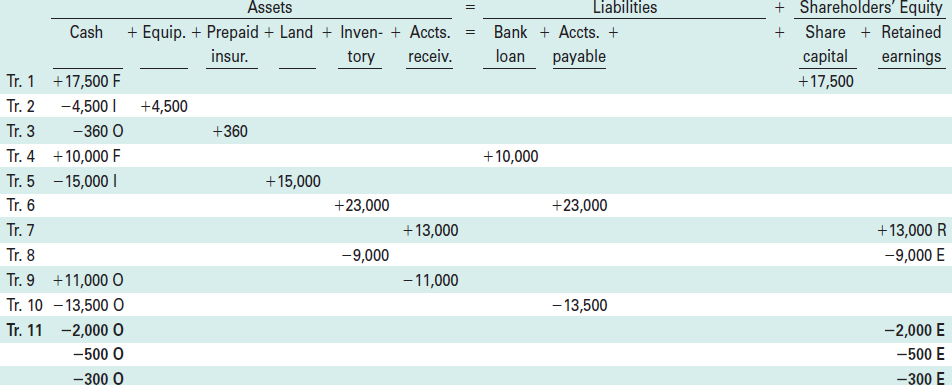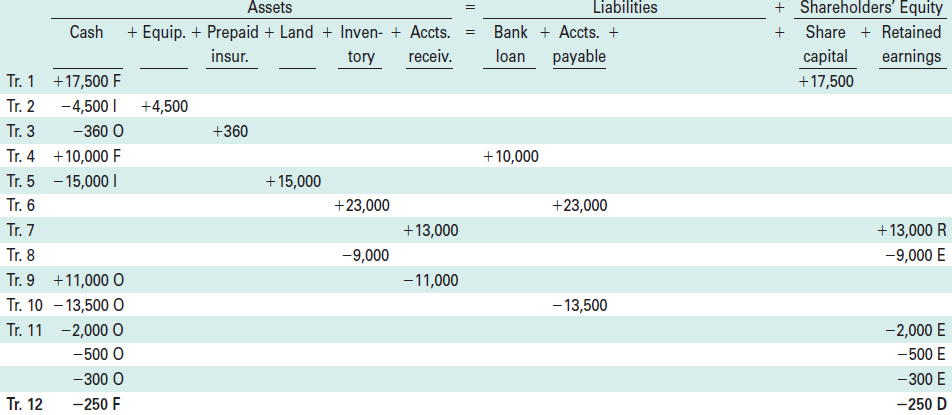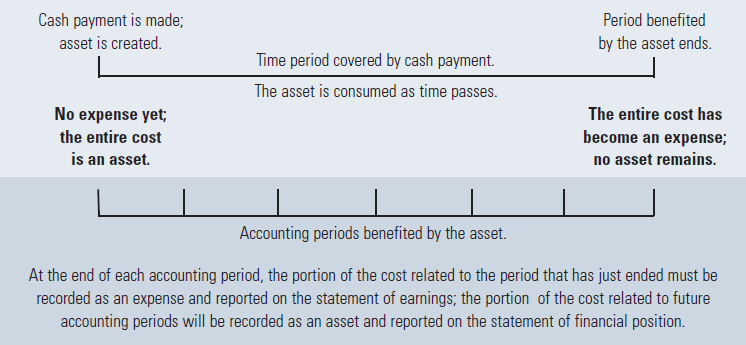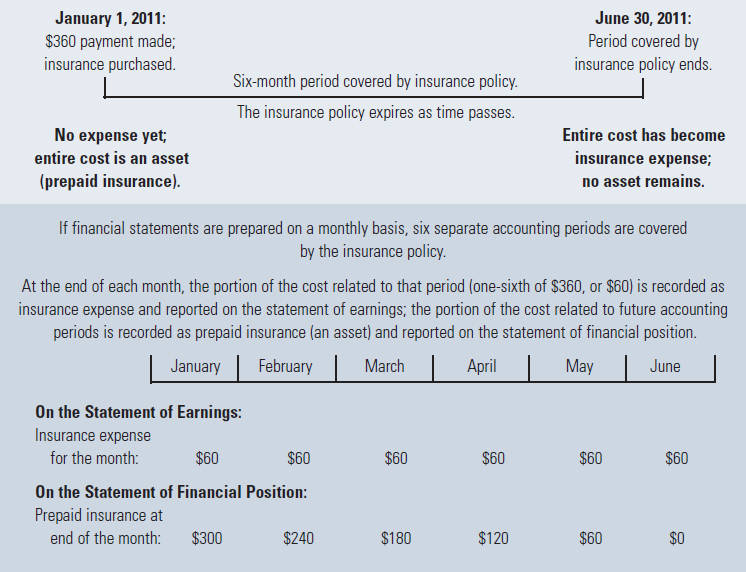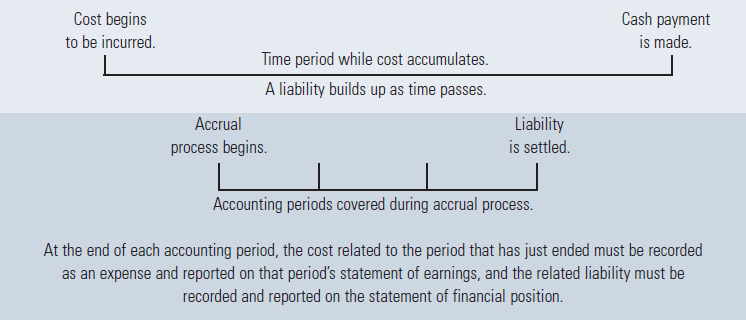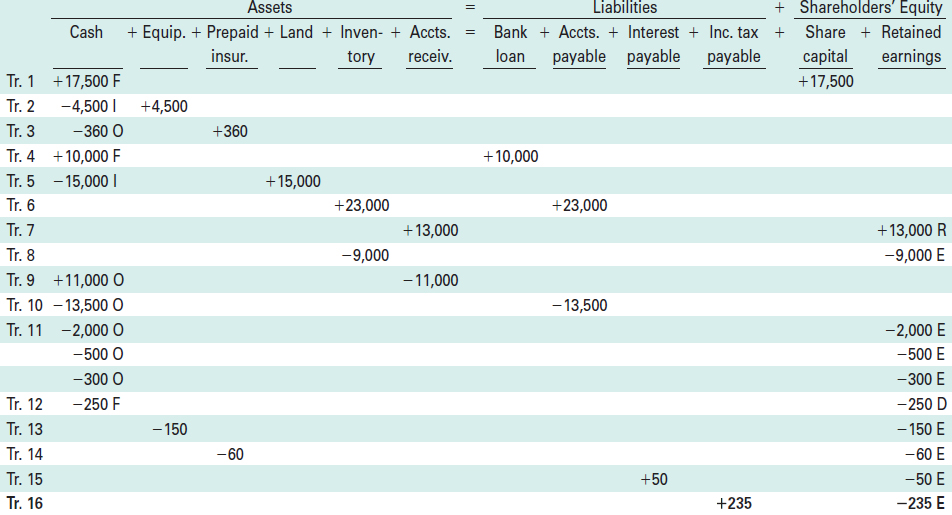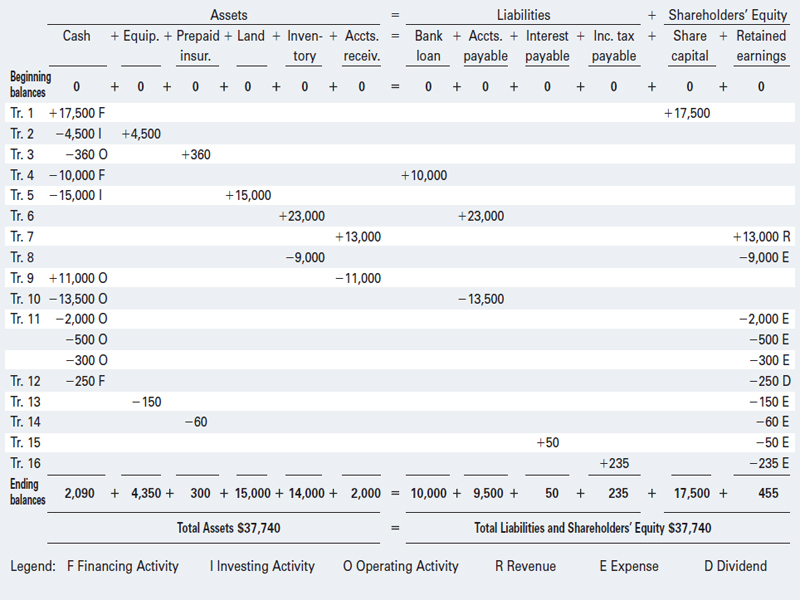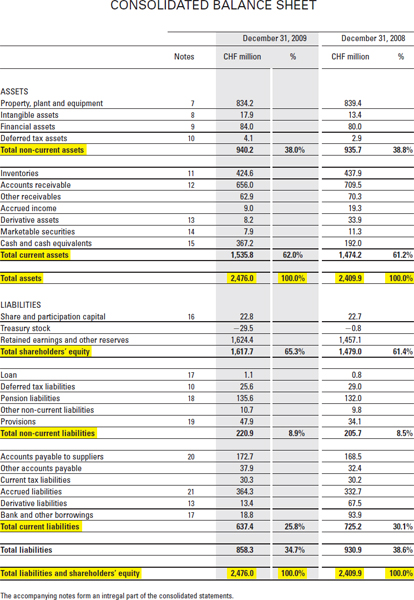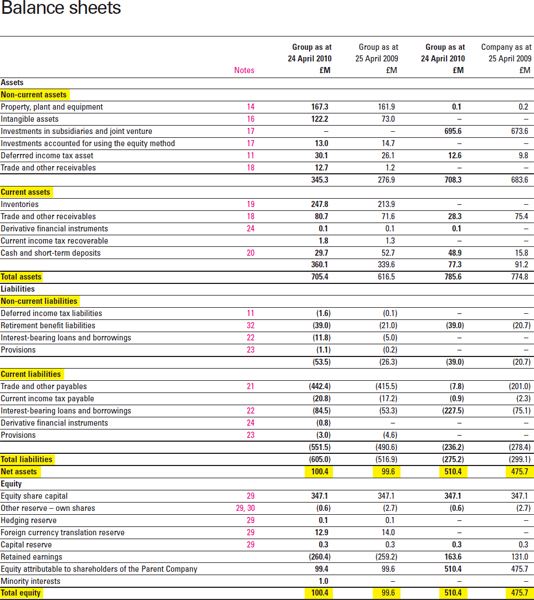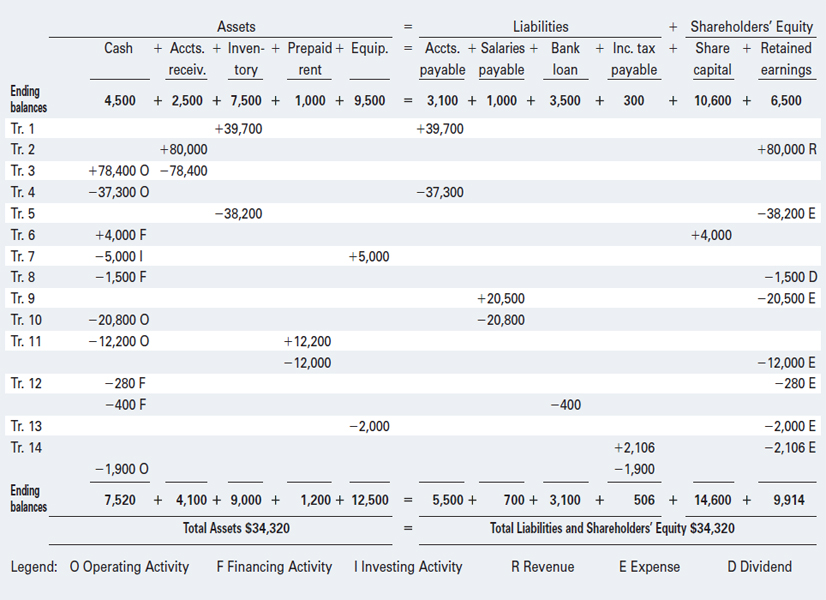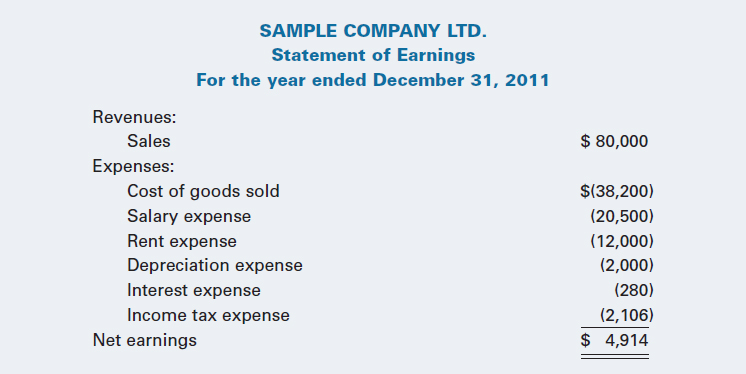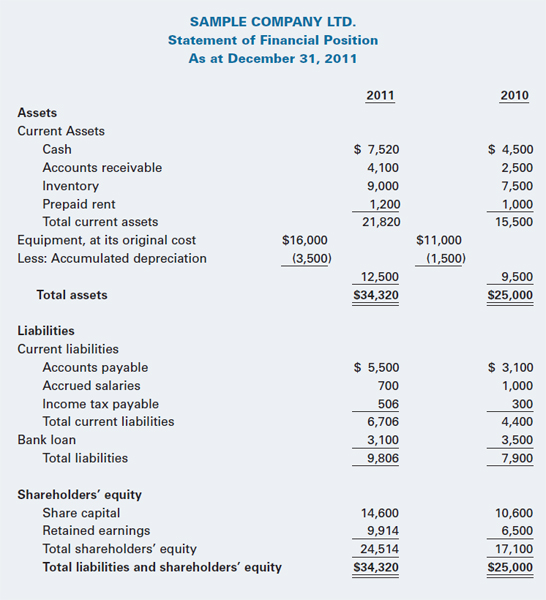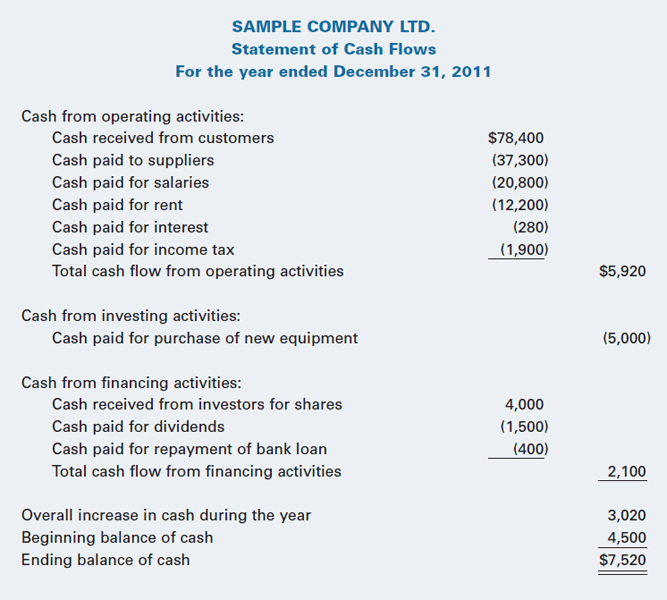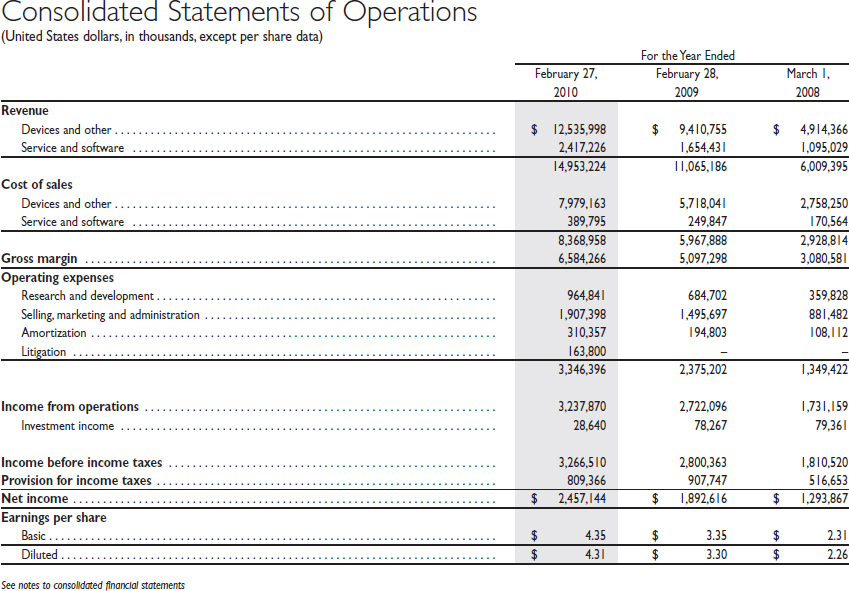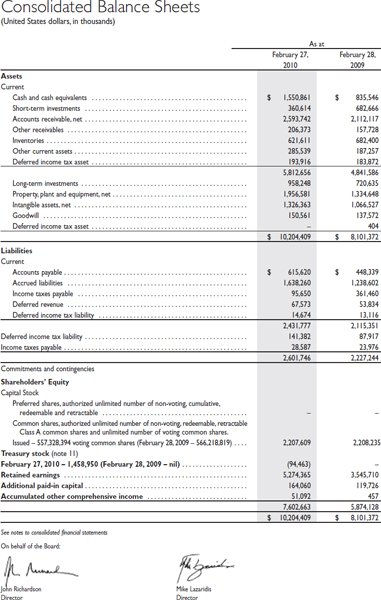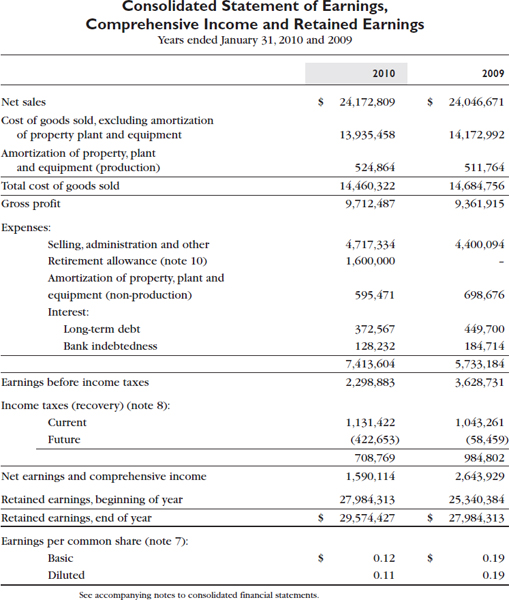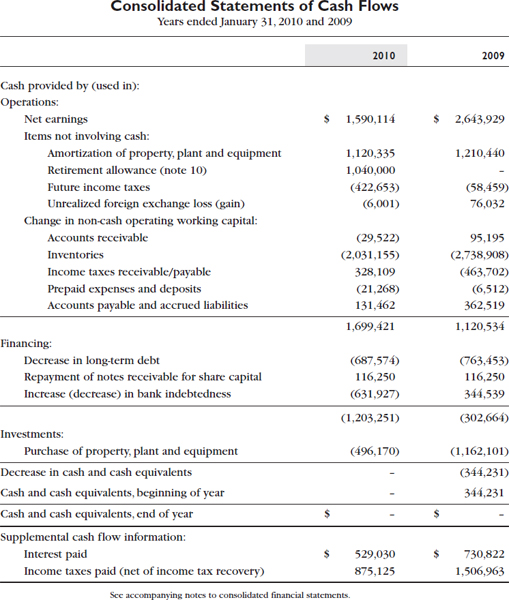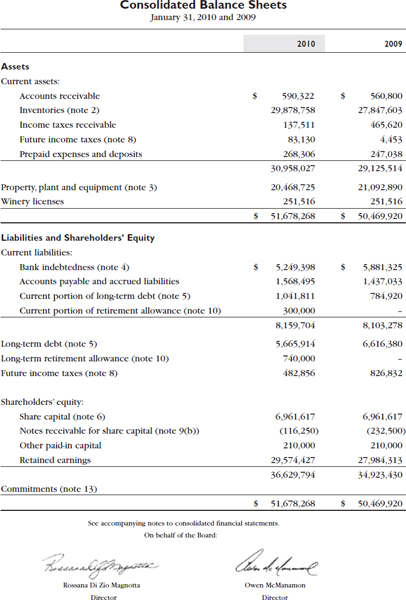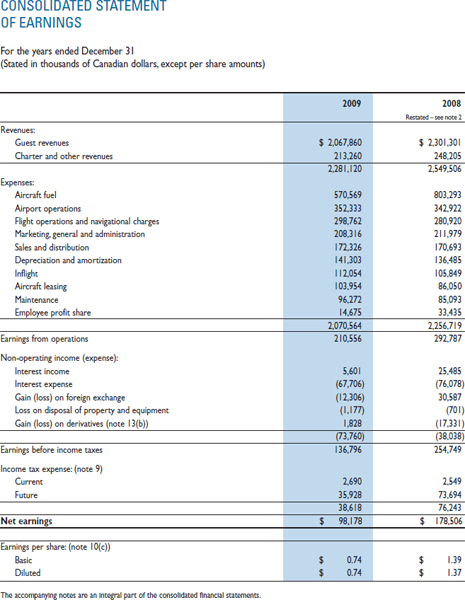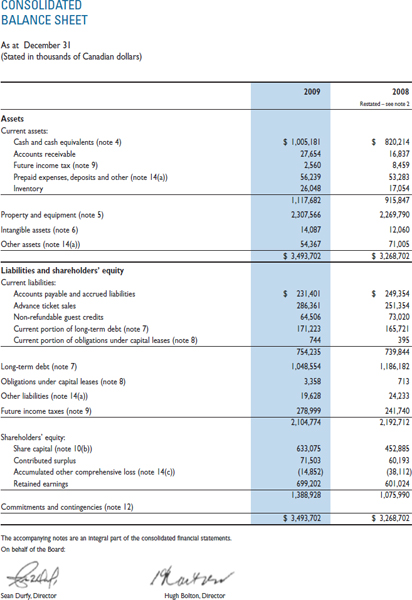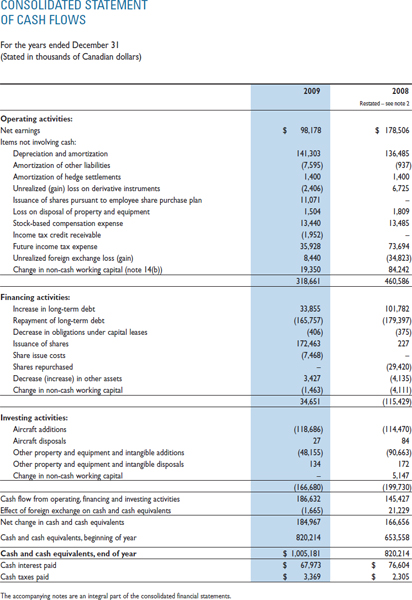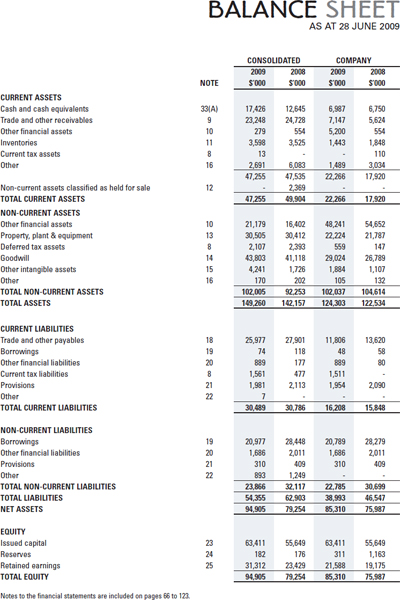chapter 2
ANALYZING TRANSACTIONS AND THEIR EFFECTS ON FINANCIAL STATEMENTS
TRANSACTION ANALYSIS AND THE BASIC ACCOUNTING EQUATION
Statement of Financial Position
Variations in Statement of Financial Position Presentation
LEARNING OBJECTIVES
After studying this chapter, you should be able to:
- Describe the basic accounting equation and each of its components.
- Analyze simple transactions to determine their effects on the basic accounting equation and the financial statements.
- Describe the difference between accrual-basis accounting and cash-basis accounting.
- Explain how inventory is accounted for when it is purchased and when it is sold.
- Identify operating activities and describe their effects on the financial statements.
- Explain the basic concepts of revenue recognition and expense matching.
- Prepare a simple set of financial statements, reflecting a series of business transactions.
- Explain the basic classification of items on a statement of financial position.
- Calculate three ratios for assessing a company's profitability.
- Begin to analyze the information provided by a statement of cash flows.
A Recipe for Success—The Evolution of a Business
Ever since high school, Chris Emery and Larry Finnson had known they wanted to go into business together. Sure enough, one day Mr. Emery's grandmother came up with an irresistible recipe for a vanilla fudge treat, and Krave's Candy Company was born. In 1996, with $20,000 scraped together from family and friends, the two Winnipeg entrepreneurs set up some old kettle cookers in a tiny industrial space and started churning out 80-pound batches of the sweets, which they called Clodhoppers.
In its first year of operation, Krave's sold its product mostly through local retailers and craft fairs. Ten years later, in 2006, they sold the Clodhoppers trademark to Brookside Foods Ltd., a manufacturer of chocolate-covered fruit and nuts based in Abbotsford, B.C. Today, Chris and Larry's Clodhoppers are sold in stores across Canada, including Wal-Mart, Zellers, Safeway, and The Bay, as well as in Blockbuster video outlets across North America.
While their company enjoyed remarkable success, Mr. Emery and Mr. Finnson, neither of whom had any prior business experience, learned a lot along the way. “At the beginning, we just thought we'd fire up a manufacturing plant and start making millions of pounds of candy and be rich within two years,” says Mr. Finnson. “It didn't work out that way. It was step by step for everything from manufacturing to money.”
During Krave's start-up period, the pair ran into unanticipated expenses. “First, we needed a computer; then there was the development of the packaging and artwork; plus we had to hire people to help us make the candy,” Mr. Emery recalls. “Before we knew it, the money was pretty much spent.” Meanwhile, as their sales continued to climb, the two had to find more cash to finance their expansion, including much needed upgrades to their production equipment: the large mixers, cooling tunnels, and other devices used in the manufacturing process.

When Krave's purchased two form-and-fill machines to weigh and package the candy, the company ensured adequate cash flow by financing the purchase with a term loan from its bank, which it got on the basis of its strong financial statements. During that first decade, as the company continued to grow, Mr. Emery and Mr. Finnson kept their financing balanced among several sources, including a venture capitalist, a traditional bank, and the Business Development Bank of Canada.
Clodhoppers' financial information is now included in the more complicated accounting structure of Brookside Foods, which is a large corporation. Information on production planning, warehouse management, product tracing, shipment scheduling, budgeting, and sales commissions for the Clodhoppers product line is added to similar information for other Brookside products to provide an overall picture of the company's operations. Still, whether running a large company like Brookside or the two-person start-up that Krave's once was, “The most important thing is to know your numbers,” Mr. Finnson says, “and how your business works from A to Z.”
Chris Emery and Larry Finnson started Krave's Candy as a small company and grew the business through hard work and effective marketing. They started with a product that they thought customers would want, and have proven that they were right. Now that their company has been taken over by Brookside Foods, several variations of their original Clodhoppers product are sold throughout North America.
It is well known that many new businesses do not survive, so what did Mr. Emery and Mr. Finnson do that made Krave's such a success? First, they had a product that people liked and would buy. Second, they worked hard at producing and distributing it. They had to ensure that the quality of the product remained consistent as they moved to producing it in larger batches. They also had to get the product to consumers. They chose to go to craft fairs first, and to convince local retailers to carry their product. As the name “Clodhoppers” became known, they were able to convince multi-outlet retailers such as The Bay, Zellers, and Shoppers Drug Mart to carry their product. This was the start of their real growth.
However, along with growth comes a need for additional funding. It is financing that often causes young companies their greatest problems, and Krave's was no exception. Within a very short time, the founders had exhausted their original investment of $20,000. Fortunately, however, by that time they were able to convince a bank that they were an acceptable credit risk. As the business evolved, they used multiple sources of funds (including a venture capitalist, as discussed in the Accounting in the News item on the following page). Investors were convinced that they had a good product, that the company was well managed, and that there was growth potential.
Behind all of its success and through all of its decisions, Krave's had to use its accounting information to manage the business. As young companies grow, the owners sometimes lose track of the numbers, especially if the growth is rapid. However, Mr. Emery and Mr. Finnson did not make that mistake. They knew that they had to keep track of all aspects of their business, and that the accounting numbers and financial statements were the tools that would enable them to do this. Therefore, as the company expanded its manufacturing and marketing operations, it also increased its accounting staff. In addition, it used computer technology to analyze its financial data efficiently and effectively.
The way Mr. Emery and Mr. Finnson started their business is typical of how many small businesses begin, with their funding obtained from personal savings, families, and friends. Financial institutions are often reluctant to take chances on new companies until they see some indicators of success, so alternative sources of financing are often required. One such source is called “venture capital,” which refers to financing provided to relatively new, potentially high-risk companies to enable them to get established.
accounting in the news
Canadian Venture Capital Financing
In the aftermath of the 2008 crisis in financial markets and the onset of a global recession, deal activity in the Canadian venture capital (VC) market in 2009 reached its lowest level since the mid-1990s. A total of $1.0 billion was invested across the country, a 27% decrease from the $1.4 billion invested in 2008, according to a report by Canada's Venture Capital & Private Equity Association (CVCA) and Thomson Reuters.
The number of VC-backed entrepreneurial firms in Canada also dropped in 2009, though not as much as the dollars invested. A total of 331 companies were financed, 15% fewer than the 388 companies financed in 2008. Amounts invested per company averaged $3.1 million in 2009, compared with $3.5 million in 2008 and $5.1 million in 2007.
The overall decline in domestic VC activity was partly offset by an increase in Quebec. A total of $431 million was invested in Quebec, up 10% from the $392 million invested in 2008, giving it a leading 43% share of the Canadian total last year. In contrast, $288 million was invested in Ontario in 2009, 50% below the $575 million invested in 2008. As a result, Ontario accounted for only 28% of the Canadian total, its lowest market share since the early 1990s.
CVCA news release, February 17, 2010, http://www.cvca.ca/files/News/CVCA_Q4_2009_VC_Press_Release_Final.pdf
USER RELEVANCE
If accounting information is to be useful, it must be (among other things) understandable and relevant. In order for users like Mr. Emery and Mr. Finnson to understand the information that is provided on financial statements, they must have at least some basic knowledge of the accounting system: what items are identified, measured, and recorded; how those items are recorded; and how financial statements are generated from the recorded data. Without that knowledge, they will have difficulty understanding the importance and relevance of accounting reports, and may not be able to use them effectively to make the best decisions.
The accounting system measures, records, and compiles information on the effects that economic events have on a company. To interpret the information in financial statements, you need to understand how accounting information is obtained and the guidelines for how it is presented in the financial statements. Only then can you use accounting information sensibly to make decisions. Chapter 1 provided an overview of the types of information that are presented in financial statements. This chapter and the next explain how accountants collect and classify that information.
LEARNING OBJECTIVE 1
Understand the basic accounting equation and each of its components.
THE BASIC ACCOUNTING EQUATION
In this chapter, we will demonstrate how a typical set of transactions affects a company's accounts, and how the three major financial statements are prepared using the transaction information. We will start with the basic accounting equation discussed in Chapter 1, which is the basis of all accounting systems.
A company's assets, liabilities, and shareholders' equity are reported on its statement of financial position, which is commonly referred to as the balance sheet. For this reason, the basic accounting equation is often called the balance sheet equation.
As transactions are recorded in the accounting system, the two sides of this equation must always remain equal. The statement of financial position provides readers with information about this equality at the beginning and end of the current accounting period—usually by showing the beginning amounts (from the previous period) in the outside column, and the ending amounts (from the current period) in the inside column. A statement with the amounts for two or more periods is called a comparative statement. Refer to H&M's balance sheet (statement of financial position) in Exhibit 1-4 for an example of this.

Users of financial information typically want to know more than just the statement of financial position amounts. They usually want to know how and why the company's financial position changed from the beginning of the period to the end. A statement of earnings and a statement of cash flows are both useful for this. In the remainder of this chapter, a set of accounts illustrating the basic accounting equation will be used to record typical transactions for a small company, and a statement of earnings and a statement of cash flows will be constructed from this information.
Companies are generally required to prepare financial statements at least once a year. However, because the financial statements provide information that is useful to management, owners, and other users, most companies prepare them more often (for example, semi-annually, quarterly, monthly, weekly, or even daily). The period of time that the financial statements cover is referred to as the accounting period. In the example we will use, the company prepares financial statements at the end of each month, so the accounting period is one month.
In Chapter 1, we explained that one of the components of shareholders' equity, share capital, increases when the owners invest money in the company and are issued shares. We also showed you that the other main component of shareholders' equity, retained earnings, increases when the company generates earnings or net income (which consists of revenues minus expenses), and decreases when the company declares dividends (distributions of earnings to the owners). In short, revenues increase retained earnings; expenses and dividends decrease retained earnings.
To help you understand the links between the financial statements and how various items are affected by transactions, each of the amounts in the retained earnings column will be labelled R for revenues, E for expenses, or D for dividends. Similarly, to help us prepare the statement of cash flows, we will label each of the amounts in the cash column as O for operating activities, F for financing activities, or I for investing activities, to indicate in which section of the statement they will be presented.
LEARNING OBJECTIVE 2
Analyze simple transactions and describe their effects on the basic accounting equation and the financial statements.
TRANSACTION ANALYSIS AND THE BASIC ACCOUNTING EQUATION
The basic accounting equation can now be used to illustrate the fundamentals of the accounting system and the preparation of financial statements. We will use typical transactions for a retail sales company to demonstrate the analysis of transactions and how they affect the financial statements.
Assume that a business called Demo Company Limited is formed as a corporation on January 1, 2011. During the month of January it engages in a number of basic transactions, as described in the sections that follow. We will discuss each of the transactions to analyze its effects on the company's accounts and financial statements.
Sample Transactions
At the beginning of January:
- The owners invested $17,500 cash and Demo Company issued shares to them.
- The company used $4,500 of the cash received from the investors to buy equipment.
- Demo paid $360 cash for an insurance policy.
- To raise additional financing, the company borrowed $10,000 from its bank.
During the rest of January:
- Demo purchased some land for $15,000.
- The company bought $23,000 of inventory from suppliers, on account (i.e., Demo will pay for the goods at a later date).
- The company sold some goods to customers for $13,000, on account (i.e., Demo will receive payment for the goods at a later date).
- The cost of the goods that were sold and removed from the company's inventory in Transaction 7 was $9,000.
- Demo received $11,000 from its customers as payments on their accounts (which originated in Transaction 7.)
- The company made payments of $13,500 to its suppliers on account (which originated in Transaction 6.)
- Demo paid the following costs for the month of January: $2,000 for salaries; $500 for rent; $300 for utilities.
- Dividends in the amount of $250 were declared and paid.
At the end of January, Demo's accountant noted that the following adjustments were required:
- Depreciation expense must be recorded for the equipment. The accountant determined that the equipment should be depreciated by $150 for the month.
- Insurance expense must be recognized for January. The insurance policy (which was purchased in Transaction 3) covers the six-month period from January 1 to June 30, 2011.
- Interest expense must be recognized for the month. The interest rate charged on the bank loan (which originated in Transaction 4) is 6% per year. Although the loan itself does not have to be repaid for five years, the interest on it has to be paid quarterly.
- Income tax expense must be recognized for the month, even though the company does not have to pay the tax until later. Demo's income tax rate is 25%.
Transaction Analysis
For each event or transaction that affects an organization, accountants must analyze its economic substance to decide what accounts are affected and by how much. We call this transaction analysis. It is at this stage of the accounting process that accounting knowledge is most needed. In addition to determining the economic substance of each transaction, accountants must know the accounting principles and guidelines that apply to the various situations that arise.
In the following subsections, we will analyze the economic substance of each of the transactions listed above, and discuss the related accounting principles underlying them. In addition, for each transaction we will show the accounts involved and the effects on the basic accounting equation, by entering the amounts in a table with columns for each of the asset, liability, and shareholders' equity accounts. Since the specific assets and liabilities that Demo Company will need are not known in advance, we will start with a basic table and add columns to it as we proceed through the analysis. Whenever we encounter a new account, we will add a new column to the table.
Transaction 1: Issuance of Shares for Cash
Demo Company issued shares in exchange for $17,500 received in cash from investors.
ANALYSIS The company's shareholders invested $17,500 in the company, in exchange for ownership rights represented by share certificates. The money the company received is recorded as an asset (cash), and the ownership rights are recorded as shareholders' equity (share capital).
The analysis of this transaction and its effects on the basic accounting equation are summarized below:
ANALYSIS OF TRANSACTION 1
Assets (specifically. Cash) increased by $17,500
Shareholders' Equity (specifically, Share Capital) increased by $17,500
EFFECTS ON THE BASIC ACCOUNTING EQUATION

Note that these entries keep the two sides of the basic accounting equation equal (in balance).
CASHFLOW EFFECT Since this transaction provides financing for the company, the cash inflow of $17,500 is classified as a financing activity and therefore has been designated with an F.
EARNINGS EFFECT Since this transaction does not involve revenues or expenses, there is no effect on the company's earnings.
RELATED CONCEPTS—The nature of revenue It is important to note that, although the issuance of shares results in an inflow of resources into the business, revenue cannot be recorded when a company sells shares to investors. Revenue has to be earned from operations of the business, and therefore only arises when the company sells goods or services to customers. The issuance of shares—even if the transaction is described as a “sale of shares”—does not involve customers, and consequently does not constitute sales revenue and will not be reported on the statement of earnings.
Transaction 2: Purchase of Equipment for Cash
Demo Company used $4,500 of its cash to buy equipment.
ANALYSIS Because the purchase required an outflow of cash, this asset decreased. At the same time, another asset—equipment—increased. The equipment is an asset, rather than an expense, because it will be used in the operations of the business and provide future benefits.
The analysis of this transaction and its effects on the basic accounting equation are summarized below:
ANALYSIS OF TRANSACTION 2
Assets (specifically. Cash) decreased by $4,500
Assets (specifically, Equipment) increased by $4,500
EFFECTS ON THE BASIC ACCOUNTING EQUATION

Again, notice that the equilibrium of the basic accounting equation has been maintained.
The equipment purchased is regarded as a long-term asset because the company will use it over several future accounting periods. The value of this asset will be used up over those future periods, and the amount that is consumed each period will be shown as depreciation expense. The expensing of part of the cost of the equipment is shown later, as one of the adjustments that is made at the end of the accounting period.
CASHFLOW EFFECT Transactions involving long-term assets are classified as investing activities. Accordingly, the cash outflow of $4,500 has been designated with an I.
EARNINGS EFFECT Since no revenue or expense is involved in this transaction, there is no effect on the company's earnings. The equipment is an asset; the expense (depreciation) related to it will be recorded later, as the asset is used.
RELATED CONCEPTS—Accrual-basis versus cash-basis accounting The treatment of this transaction is based on an assumption of accrual-basis accounting. Under accrual accounting, costs (such as the cost of the equipment) are only classified as expenses if and when the item is consumed; until that time, the cost is recorded as an asset. In this transaction, therefore, the purchase of the equipment is not recorded as an expense. The equipment is recorded as an asset, because it will be used in the future. One asset (cash) has simply been exchanged for another asset (equipment) and there is no effect on the company's income, or change in its shareholders' equity.
LEARNING OBJECTIVE 3
Describe the difference between accrual-basis accounting and cash-basis accounting.
Accrual-basis accounting is very different from cash-basis accounting, which classifies costs as expenses whenever cash is spent. In a cash-basis system, the purchase of equipment would be recorded as an expense and reported on the statement of earnings. However, as will be discussed in detail in Chapter 4, cash-basis accounting violates generally accepted accounting principles (GAAP). The accrual basis is consistent with GAAP, is used by most businesses, and will be used throughout this book.
Transaction 3: Purchase of Insurance
Demo Company paid $360 in cash for an insurance policy.
ANALYSIS This transaction is an example of a prepaid expense. The cost of insurance coverage is paid in advance of the coverage period. Therefore, at the date of the payment the cost of the policy should be shown as an asset, since it has not been used up yet. Only as time passes will the asset (the insurance coverage) be consumed.
HELPFUL HINT
Note that this is an example of the concept that a cost can be classified as either an asset or an expense, depending on whether or not it has expired (i.e., been consumed). Unexpired costs are assets, while expired costs are expenses.
Because the purchase required an outflow of cash, this asset decreased. However, another asset—prepaid insurance—increased.
The analysis of this transaction and its effects on the basic accounting equation are summarized below:
ANALYSIS OF TRANSACTION 3
Assets (specifically, Prepaid Insurance) increased by $360
Assets (specifically, Cash) decreased by $360
EFFECTS ON THE BASIC ACCOUNTING EQUATION

CASHFLOW EFFECT This transaction decreases cash by the $360 payment, which represents an operating cash flow and has therefore been designated with an O.
EARNINGS EFFECT Since this transaction does not involve revenue or expenses, there is no effect on the company's earnings. The insurance is not an expense until it is used up.
Transaction 4: Loan from Bank
Demo Company borrowed $10,000 from the bank.
ANALYSIS In addition to issuing shares to investors, a company can also raise money by taking out a loan. In this case, Demo borrowed $10,000 from the bank. The effect of this transaction is to increase cash and create an obligation (liability) that shows the amount owed to the bank.
The amount that was borrowed is called the principal of the loan. The principal does not include interest. As time passes, interest will be added to the amount owed to the bank. For example, if the interest rate on this loan is 6% per year (interest rates are generally stated on an annual basis), the interest added during the first year of the loan will be 6% of the $10,000 principal, $600. Using accounting terminology, interest accrues on the loan as time passes. At the point of acquiring the loan, however, only the principal is recorded; since no time has passed since the loan was taken out, no interest has accrued.
The analysis of this transaction and its effects on the basic accounting equation are summarized below:
ANALYSIS OF TRANSACTION 4
Assets (specifically, Cash) increased by $10,000
Liabilities (specifically, Bank Loan) increased by $10,000
EFFECTS ON THE BASIC ACCOUNTING EQUATION

CASHFLOW EFFECT Since taking out a loan from the bank is a financing activity, the resulting cash inflow is designated with an F.
EARNINGS EFFECT Since no revenue or expense is involved in this transaction, there is no effect on the company's earnings.
RELATED CONCEPTS—The nature of revenue As with the issuance of shares (discussed in Transaction 1), taking out a loan creates an inflow of resources into the business; however, no revenue is recorded when a company borrows money. Revenue has to be earned from the operations of the business. Getting financing from creditors does not involve selling goods or services to customers, and consequently does not involve revenue. (In fact, as we will see in Transaction 15, the opposite occurs: when interest is charged on the debt, interest expense must be recorded.)
Transaction 5: Purchase of Land for Cash
Demo Company purchased land for $15,000.
ANALYSIS The purchase of land for cash means that cash decreases by the amount of the purchase price and another asset, land, increases by the same amount.
The analysis of this transaction and its effects on the basic accounting equation are summarized below:
Assets (specifically, Cash) decreased by $15,000
Assets (specifically, Land) increased by $15,000
EFFECTS ON THE BASIC ACCOUNTING EQUATION

CASHFLOW EFFECT Since purchasing a long-term capital asset such as land is classified as an investing activity, the resulting cash outflow is designated with an I.
EARNINGS EFFECT Since this transaction does not involve revenues or expenses, there is no effect on the company's earnings.
RELATED CONCEPTS Land is an asset because it has probable future value and the company holds title to it. The probable future value can be viewed as either its future sale price or the value to be derived from its future use. As with other assets, land should be recorded at its acquisition cost. Unlike other long-term capital assets, however, land is not depreciated. This is because it is not consumed the way other capital assets are. Capital assets such as buildings and equipment can be used for only a limited period of time before they wear out from use, but land can typically be used for an unlimited period.
Transaction 6: Purchase of Inventory on Account
Demo Company purchased $23,000 of inventory, on account.
ANALYSIS “On account” means that Demo has been extended credit by its suppliers and will be required to pay for the inventory at a later date.
The substance of this transaction is that the company has received an asset (inventory) from a supplier and, in exchange, has given the supplier a promise to pay for the inventory at a later date. The promise to pay represents an obligation of the company and is therefore recorded as a liability. These types of liabilities are usually referred to as accounts payable.
The term “account payable” means an account that Demo will have to pay in the future. It must be recorded as a liability on the day the inventory is purchased, even though the payment is not due until later.
The analysis of this transaction and its effects on the basic accounting equation are summarized below:
ANALYSIS OF TRANSACTION 6
Assets (specifically, Inventory) increased by $23,000
Liabilities (specifically, Accounts Payable) increased by $23,000
CASHFLOW EFFECT This transaction has no immediate impact on cash, since no cash has changed hands yet. Cash will be affected later, when the company pays the amount owed to the supplier.
EARNINGS EFFECT Since no revenue or expense is involved in this transaction, there is no effect on the company's earnings. Net earnings (and therefore retained earnings) will be affected only when the inventory is sold.
RELATED CONCEPTS As with Transactions 2, 3, and 5, this transaction involves the purchase of an asset. The inventory will be held until it is sold, and should be shown as an asset on the statement of financial position until that time. The cost of goods purchased for inventory is, therefore, classified as an asset until the company sells the inventory. There is no immediate impact on the statement of earnings from this transaction. It will only affect the statement of earnings later, when the inventory is sold.
As with most other assets, the valuation principle for inventory is that it should be recorded at its acquisition cost (i.e., the price paid to obtain it). Accordingly, the inventory is recorded at the amount that the company has to pay for it (its cost), not the amount it will be sold for (its resale value).
Accounts payable are generally settled in a short time period (typically 30 days), and there is generally no interest charged on accounts payable, even though they are equivalent to loans from the supplier.
Occasionally, inventory or other assets are purchased on longer-term credit and a formal loan document called a note payable is prepared, as evidence of the liability. In the case of a note payable, interest is usually charged. The interest would be recorded as an expense and as either an outflow of cash, if it is paid, or as an additional liability (interest payable) if it is going to be paid later. Accounting for interest is explained further in Transaction 15.
LEARNING OBJECTIVE 4
Explain how inventory is accounted for when it is purchased and when it is sold.
Transaction 7: Sales on Account
Demo Company sold some of its inventory to customers, on account, for $13,000.
ANALYSIS The substance of a sale transaction is that a company exchanges an asset that it has for an asset that a customer has. The sale may involve goods (items of inventory), if the company is a retailer, wholesaler, or manufacturer; or it may involve services, if the company is a service provider. In this case, Demo sells goods and the asset it provides is inventory. The asset it receives in exchange from its customers is generally cash, but other possibilities exist. For example, companies often agree to make sales based on customers' promises to pay later. These are called sales on account, or credit sales, and they result in the company getting the right to receive payment, usually called accounts receivable, in exchange for its goods. An account receivable is an amount that the seller is entitled to receive in the future, when the payment is due from the customer. It is recorded as an account receivable on the day the sale occurs, even though the amount is not due to be received until later.
Because this is an exchange, there are two parts of the transaction to consider: the inflow of the asset that is received, and the outflow of the asset that is given up. The inflow results in an increase in an asset (accounts receivable) and is also recorded as a revenue, which causes an increase in the shareholders' equity (retained earnings). The outflow results in a decrease in an asset (inventory) and is also recorded as an expense, which causes a decrease in the shareholders' equity (retained earnings). If the inflow or revenue is more than the outflow or expense, the company has generated income or a profit from the transaction. If the inflow (revenue) is less than the outflow (expense), the company has experienced a loss on the exchange.
LEARNING OBJECTIVE 5
Identify operating activities and describe their effects on the financial statements.
The increases and decreases in shareholders' equity from sales transactions such as this are typically called sales revenue and cost of goods sold (a type of expense), respectively.
Because the analysis which follows focuses on the basic accounting equation, the effects of both the sales revenue and the cost of goods sold (expense) will be shown as affecting the retained earnings portion of shareholders' equity. Remember from our earlier discussion that net income (revenues minus expenses) increases retained earnings. Therefore, it should be logical that revenues increase retained earnings and expenses decrease retained earnings. Showing revenues and expenses as increases or decreases in retained earnings is a temporary shortcut that we use in this chapter, to introduce you to the analysis of transactions. In future chapters, revenues and expenses will be recorded in their own accounts.
The remaining question in the analysis is how to value the inflow and the outflow. The inflow (revenue) should be recorded using the selling price of the goods being sold, while the outflow (expense) should be recorded using Demo's cost of the goods sold. Based on the information in Transaction 7, the selling price of the goods sold was $13,000. Therefore, retained earnings (sales revenue) and assets (accounts receivable) will both be increased by $13,000.
Transaction 7 gives no information about the cost of the goods that were sold; this is covered in Transaction 8. Although it may seem odd to analyze and record these two simultaneous events separately, it is necessary because they involve two different values: the retail price at which Demo sells the goods to its customers, and the cost price at which Demo bought the goods from its suppliers. For the same reason, when a clerk in a store rings up a sale, a record is made of the sales revenue and the increase in cash (or accounts receivable, in the case of a sale on account), but the salesperson usually does not know the cost of the item that is being sold. The cost is determined and recorded separately, as it will be for Demo in Transaction 8.
The analysis of Transaction 7 and its effects on the basic accounting equation are summarized below:
ANALYSIS OF TRANSACTION 7
Assets (specifically, Accounts Receivable) increased by $13,000
Shareholders' Equity (specifically, Retained Earnings) increased by $13,000
Notice that the basic accounting equation is still in balance after these entries are made.
CASHFLOW EFFECT This transaction has no immediate effect on cash. Because this sale is on account, the effect on cash will not occur until Demo collects the account receivable.
EARNINGS EFFECT Since sales are revenues that will be reported on the statement of earnings, the amount in the retained earnings column has been designated with an R.
RELATED CONCEPTS—Revenue recognition The timing of the recognition of revenues and expenses is an important decision that management must make in recording transactions and preparing financial statements. There is an underlying conflict between reporting income information in a timely manner and being assured that the information is reliable.
Consider three possible points in time for when a sale could be recorded:
- At one extreme, it might be argued that a company should record a sale as soon as a customer signs a contract for the future delivery of inventory, even though the goods have not yet been delivered and the customer has not yet paid for them.
- At the other extreme, it might be argued that the sale should not be recorded until the entire process has been completed (i.e., when the company has made the delivery and the customer has paid for the goods).
- As an intermediate position, it might be argued that the sale should be recorded when the company delivers the goods, even though the customer has not yet paid for them.
- In the first case, the company would be assuming that it will eventually deliver the goods to the customer and collect the cash from the sale. However, these are both uncertain events that may not materialize. A statement of earnings prepared on this basis would be very timely but not totally reliable, and shareholders might be misled into thinking that the company is doing better than it really is.
- In the second case, by delaying recognition of the sale until the goods have been delivered and the cash has been collected, all the uncertainty will have been resolved; however, a significant amount of time may have passed. A statement of earnings prepared on this basis would be totally reliable but not very timely, and would not provide a good measure of the company's business activity during the period(s) before the cash is collected.
- In the third case, by delaying recognition of the sale until the goods have been delivered the uncertainty about the delivery will be resolved, but not the uncertainty about the collection of the cash. A statement of earnings prepared on this basis would be less timely but more reliable than the first case, and more timely but less reliable than the second case.
LEARNING OBJECTIVE 6
Explain the basic concepts of revenue recognition and expense matching.
The accrual basis of accounting attempts to balance the trade-off between timeliness and reliability, and measures performance (by recording revenues and expenses) in the period in which the performance takes place. Under the accrual basis of accounting, revenue recognition criteria are used to determine when revenue should be recorded (i.e., when the earning process has been substantially completed). Chapter 4 discusses these criteria in detail, so the following discussion will deal only with general principles.
Generally, revenue should not be recorded when a customer places an order or signs a contract (as described in the first case above), because the company has not completed the major things it must do to earn the revenue. The company must still deliver the goods, which is a major part of the earning process. On the other hand, it would not usually be necessary for the company to wait until the cash is collected and the entire process is finished (as described in the second case above) before the revenue could be recognized. In most situations, the revenue can be recorded when the company delivers the goods (as described in the third case above), as long as it is reasonably sure that it will be able to collect the cash.
The revenue recognition criteria used under the accrual basis of accounting provide shareholders with assurance that the amounts reported as revenues and expenses on the statement of earnings are reasonable, and that it is very likely that the revenues and expenses that have been recorded will ultimately result in similar cash flows.
As mentioned earlier, the alternative to the accrual basis is the cash basis of accounting. If the cash basis were used, events would be recorded whenever their cash effects occur. For example, sales revenue would be recorded when cash is received from customers, and the cost of goods sold expense would be recorded when the cash is paid for purchases of inventory. As a result, on this basis you could record revenues from selling inventory in a later accounting period than the expenses for purchasing it. Or, if the company purchased its inventory on account (to be paid for later), you could record revenues from selling the inventory in an earlier period than you record the expenses for purchasing it. In either case, you would have the revenue recorded in one accounting period and its associated expense in another, and the statement of earnings would not show the company's performance in a meaningful way. This is the main reason why the cash basis of accounting is not used very often. (In the past, most not-for-profit organizations used the cash basis, but today most of them have switched to the accrual basis of accounting. However, the cash basis is still used by some not-for-profit organizations, farmers, fishers, and professional service companies.)
For a retail business such as Demo Company, the revenue recognition criteria are generally met when the inventory is transferred to the customer. Therefore, in the preceding analysis, the result of Transaction 7 is to recognize revenues (which increases the retained earnings). We assume that once the goods have been delivered, Demo knows how much it has earned and is reasonably sure that it will be able to collect its accounts receivable. Therefore, it should recognize revenues when the goods are transferred to customers, and not wait until the cash is collected.
Another equally important aspect of accrual-basis accounting is the matching concept. This principle of accounting requires that all the costs that are associated with generating sales should be matched on the statement of earnings with the revenue that has been earned. That is, the cost of goods sold (and any other expenses) related to this revenue should be recognized in the same period and reported on the same statement of earnings as the sales revenue. Transaction 8 deals with the cost of goods sold related to this transaction.
Transaction 8: Cost of Goods Sold
The cost of the items that were sold and removed from inventory during January was $9,000.
ANALYSIS As explained in the analysis of Transaction 7, there are two parts to sales transactions. Transaction 7 dealt with the revenue side of the January sales. In this transaction, the costs or expenses that are to be matched with the revenues are analyzed.
The effect of the outflow of the items that were sold is to decrease both the assets (inventory) and the shareholders' equity (retained earnings) by the cost of the goods that have been sold to customers. The cost of goods sold is an expense, which decreases the net income and retained earnings. It is one of the many expenses that the company will show on its statement of earnings.
The analysis of this transaction and its effects on the basic accounting equation are summarized below:
ANALYSIS OF TRANSACTION 8
Assets (specifically, Inventory) decreased by $9,000
Shareholders' Equity (specifically, Retained Earnings) decreased by $9,000
EFFECTS ON THE BASIC ACCOUNTING EQUATION

CASHFLOW EFFECT This transaction has no effect on cash. The cash flow effects of inventory transactions occur when payments are made for the goods that were purchased.
EARNINGS EFFECT The cost of goods that have been sold is an expense that will be reported on the statement of earnings. Accordingly, the amount in the retained earnings column has been designated with an E.
RELATED CONCEPTS—The matching principle As explained earlier, in the analysis of Transaction 7, when revenues are recognized the matching concept requires that the expenses associated with those revenues be recognized as well. Under accrual-basis accounting, the cost of inventory is held in an asset account until it is sold; when it is sold, it is transferred to an expense account. This illustrates a very important concept, so further elaboration is warranted: Under accrual-basis accounting, a cost can be classified as either an asset or an expense, depending on its nature.
- If the cost represents something that still has value to the company and will be of economic benefit to it in the future, it is classified as an asset and reported on the statement of financial position.
- If the cost represents something that has already given up its value to the company and will not be of further benefit to it in the future, it is classified as an expense and reported on the statement of earnings.
Many costs are initially classified as assets but eventually reclassified as expenses. For example, while Demo holds the inventory, its cost is recorded as an asset (inventory); but when the inventory is sold, its cost ceases to be an asset and must be transferred to an expense account (cost of goods sold). For a retailer such as Demo, the inventory's cost is the wholesale price that Demo paid to acquire it.
Transaction 9: Collections from Customers on Account
During the month, Demo Company received $11,000 from customers as payments on their accounts.
ANALYSIS The receipt of cash from customers increases Demo's cash. Because the company received this money from its customers as payments on their accounts, the value of the accounts receivable decreases by the amount of the payments received.
The analysis of this transaction and its effects on the basic accounting equation are summarized below:
ANALYSIS OF TRANSACTION 9
Assets (specifically, Cash) increased by $11,000
Assets (specifically, Accounts Receivable) decreased by $11,000
EFFECTS ON THE BASIC ACCOUNTING EQUATION

CASHFLOW EFFECT Since collecting cash from customers is a basic operating activity for a business, the amount in the cash column has been designated with an O to indicate that it will be reported under operating activities on the statement of cash flows.
EARNINGS EFFECT It is extremely important to note that this transaction does not involve revenues, and therefore does not affect the company's earnings.
RELATED CONCEPTS The effect on the company's earnings was recorded earlier, in Transaction 7, when the original sale occurred and the revenue was earned. Since the revenue was already recognized when the sale was made, there is no revenue recorded when the account is collected; one asset (accounts receivable) is simply replaced by another asset (cash).
Accounts receivable are generally short-term credit arrangements (typically for a period of 30 days), and do not usually involve interest charges. If this were a note receivable (indicating that a formal document had been prepared and signed, as evidence of the obligation), interest charges would probably be specified. When the customer's payment includes interest, the amount of cash received is more than the selling price and the extra amount is recorded as interest revenue.
Transaction 10: Payments to Suppliers on Account
Demo Company made payments of $13,500 on its accounts payable.
ANALYSIS Cash payments made by the company result in a decrease in an asset—cash. In this case, because the payment is being made for goods that were purchased earlier, on account, there is a corresponding decrease in a liability—accounts payable.
The analysis of this transaction and its effects on the basic accounting equation are summarized below:
ANALYSIS OF TRANSACTION 10
Assets (specifically, Cash) decreased by $13,500
Liabilities (specifically, Accounts Payable) decreased by $13,500
EFFECTS ON THE BASIC ACCOUNTING EQUATION

CASHFLOW EFFECT Because paying cash to its suppliers is a basic operating activity for a business, the amount in the cash column has an O beside it to indicate that the cash outflow will be reported under operating activities on the statement of cash flows.
EARNINGS EFFECT Note that paying this debt does not result in an expense being recorded; there is simply a decrease in an asset and a corresponding decrease in a liability. Therefore, there is no effect on the company's earnings.
RELATED CONCEPTS Accounts payable are, of course, the opposite of accounts receivable. Whenever a purchase or sale is made on account, the party making the purchase records an account payable, and the party making the sale records an account receivable.
With accounts payable, there are typically no interest charges (unless the accounts are overdue). However, longer-term financing arrangements (usually represented by notes payable) almost always involve interest charges. When interest is involved, the total amount paid to settle the obligation has to be divided between the amount that is repayment of the original liability (i.e., the principal amount of the debt) and the amount that is payment of the interest expense.
Note again that shareholders' equity (retained earnings) is not affected by Transaction 10. The income effects related to inventory are recorded in the period when the inventory is sold, because that is when the cost of the inventory is transferred to an expense account (cost of goods sold). This could occur either before or after the payment of cash to the supplier.
Transaction 11: Cash Expenses
Demo Company paid the following costs for the month of January: $2,000 for salaries; $500 for rent; $300 for utilities (telephone, electricity, water, etc.).
ANALYSIS Because they were incurred to operate the business for the month of January, rather than to acquire something that will be used up in the future, the costs in this transaction should be recorded as expenses for January. (Remember that unexpired costs are assets, and expired costs are expenses.) Expenses reduce net earnings for the period, which will reduce retained earnings.
Because the payments of these costs required outflows of cash, the asset cash is decreased. This is counter-balanced (i.e., the accounting equation is kept in balance) by a decrease in the retained earnings portion of shareholders' equity, representing the effect of the expenses. Note that, in order to provide as much information as possible about the operation of the business, each of these expenses is listed separately. This ensures that when the statement of earnings is prepared the details of the company's expenses can be shown.
The analysis of this transaction and its effects on the basic accounting equation are summarized below:
ANALYSIS OF TRANSACTION 11
Assets (specifically, Cash) decreased by $2,000, $500, and $300
Shareholders' Equity (specifically, Retained Earnings) decreased by $2,000, $500, and $300
CASHFLOW EFFECT Since these payments are related to the operation of the business, they are classified as operating cash flows. Accordingly, the amounts entered in the cash column have an O beside them.
EARNINGS EFFECT Since these costs are expenses, the amounts listed in the retained earnings column have an E beside them and will be reported on the statement of earnings.
Transaction 12: Declaration and Payment of Dividends
Demo Company declared and paid dividends of $250.
ANALYSIS Dividends are payments to the shareholders of the company, as authorized by the company's board of directors. They distribute part of the company's earnings to its owners. They are not expenses, because they are not incurred to operate the business and generate revenues.
When dividends are declared (i.e., announced by the directors of the company), the effect is to reduce the shareholders' equity (retained earnings) and either to decrease the assets (cash), if the dividends are paid immediately, or to increase the liabilities (dividends payable), if they are to be paid later. In this case, the dividends were declared and paid, so cash is reduced.
The analysis of this transaction and its effects on the basic accounting equation are summarized below:
ANALYSIS OF TRANSACTION 12
Assets (specifically, Cash) decreased by $250
Shareholders' Equity (specifically, Retained Earnings) decreased by $250
CASHFLOW EFFECT Because dividends are related to the company's shares (which are a primary source of financing for a business), the payment of dividends is generally classified as a financing activity. Accordingly, the outflow in the cash column has an F beside it.
EARNINGS EFFECT Notice that, in the shareholders' equity section of the equation, the decrease in the retained earnings column has a D beside it to indicate that this amount represents dividends, not expenses. This is an important distinction because, although dividends and expenses both reduce a company's retained earnings, dividends are not part of the calculation of net income and do not appear on the statement of earnings.
RELATED CONCEPTS Dividends are determined and announced (declared) by a vote of a company's board of directors. On the date of declaration, they become a legal obligation of the company. If there is a delay between the date the dividends are declared and the date they are paid, a liability (dividends payable) exists between these dates. In the case of Demo Company, however, the dividends are declared and paid in the same accounting period, so the dividends payable account is ignored.
Dividends explain part of the change in retained earnings from the beginning of the period to the end of the period. As discussed previously, net earnings (consisting of revenues minus expenses) increase a company's retained earnings, and dividends declared decrease the retained earnings.
Finally, note once again that dividends are not expenses and do not appear on the statement of earnings.
Transaction 13: Depreciation Expense
Demo Company's accountant determined that the equipment should be depreciated by $150 for the month of January.
ANALYSIS Whenever an expenditure is made to acquire an asset, there are three general questions to ask about the nature of the transaction:
- Has an asset been created?
- If so, what is the value of the asset?
- When is the value of the asset consumed, or when does the asset cease to exist?
To answer the first question, the criteria for recognizing an asset must be considered. Does the item have probable future value, and does the company own it or have the exclusive right to use it? If the answers to both of these questions are yes, an asset exists and should be recorded.
When Demo originally purchased its equipment, the answer to both of these asset recognition questions was yes. Demo owned the equipment and it had future value, because the equipment was to be used to help operate the business and thus generate revenues. The equipment, therefore, was recorded as an asset when it was purchased (in Transaction 2).
The answer to the second question, regarding the value of the asset, is simply that, according to GAAP, the equipment is valued at its acquisition cost (sometimes called historical cost). In this example, the $4,500 that was paid for the equipment when it was purchased represents its historical cost.
The third question (When is the value of the asset consumed, or when does the asset cease to exist?) is a little more difficult to answer. For an asset such as inventory, the answer is relatively simple: the value of the asset is consumed and the asset ceases to exist when it is sold. As a result, inventory simply stays on the statement of financial position as an asset until it is sold; when it is sold, its cost is transferred to an expense (cost of goods sold) on the statement of earnings. For an asset such as equipment, the answer is more complicated. In the case of a long-term asset such as equipment, the asset's value is consumed as time passes and the equipment is used. Consequently, the asset's useful life (the time until it will cease to have value) must be estimated. For example, the equipment may be expected to last for five years, at which time it will either be sold, traded in for a new piece of equipment, or discarded.
Because an asset such as equipment is used up over time, its value does not simply stay unchanged on the statement of financial position from one period to another. Instead, to fairly measure the company's net income and satisfy the matching principle, some of its cost should be shown as an expense for each of the periods in which it is used. In other words, we should transfer some of the cost of the asset to an expense account each period, so that the cost of using the equipment will appear on the statement of earnings at the same time as the revenues that are generated from using it. The portion of the asset's cost that is transferred to expense each period is called depreciation or amortization.
The amount of depreciation (or amortization) expense in any particular period should reflect the portion of the asset's value that was used up during that time. There are many factors to consider in determining the appropriate amount, and therefore many methods for calculating how much the depreciation expense should be each period. Chapter 8 discusses these methods in detail.
The simplest and most common method is straight-line depreciation. It assumes that an asset's value is consumed evenly throughout its life and therefore charges the same amount of depreciation expense in each accounting period. The formula for calculating straight-line depreciation is:

Note that two estimates are required in this calculation. First, the useful life of the asset must be estimated. This could be expressed in years or months, depending on the length of the accounting period. In the Demo Company example, we will be preparing financial statements at the end of each month, so the depreciation expense should be calculated as an amount per month. The second estimate is the residual value of the asset. This is how much the asset is expected to be worth at the end of its useful life. For example, if Demo's equipment is expected to have a useful life of two years (24 months) and a residual value of $900 at the end of its life, the monthly depreciation would be calculated as follows:

At the end of each month, Demo would reduce the value of the asset (the equipment) on the statement of financial position by $150, and show a $150 expense (depreciation) on the statement of earnings.
The analysis of this transaction and its effects on the basic accounting equation are summarized below:
ANALYSIS OF TRANSACTION 13
Assets (specifically, Equipment) decreased by $150
Shareholders' Equity (specifically, Retained Earnings) decreased by $150
EFFECTS ON THE BASIC ACCOUNTING EQUATION
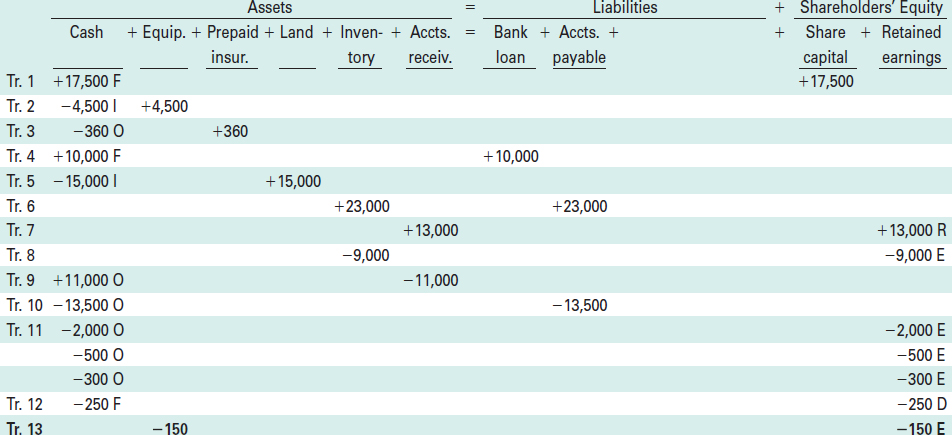
CASHFLOW EFFECT This transaction has no effect on cash. The cash outflow for the equipment occurred in the period when it was purchased. There might be a cash inflow in the future, when the equipment is sold at the end of its useful life. However, during the asset's life, depreciation simply transfers a portion of the equipment's cost from the asset account to an expense account; it does not involve cash.
EARNINGS EFFECT Notice that the amount deducted in the retained earnings column has an E beside it, indicating that it is an expense and will therefore be reported on the statement of earnings.
HELPFUL HINT
The process of depreciating a capital asset is just one example of how a cost can be initially recorded as an asset but eventually transferred to an expense as time passes and the cost expires (i.e., the benefits provided by the asset are consumed). Conceptually, it is similar to how a prepaid expense is handled, as illustrated in Transaction 14.
RELATED CONCEPTS—Depreciation As will be discussed further in Chapter 8, the choice of which depreciation method should be used is influenced by several factors, including the nature of the asset and how the company will use it. To achieve a good matching of revenues and expenses, a company should choose the depreciation method that best reflects the pattern of the economic benefits that will be received from using the asset.
Note that, in the table above, the $150 reduction of the asset's value has been taken directly out of the equipment account. In actual practice, however, the reduction in the value of a capital asset due to depreciation is kept in a separate account, called accumulated depreciation. Over time, this account collects (i.e., accumulates) all the reductions in the asset's value. When a statement of financial position is prepared, the balance in the accumulated depreciation account is deducted from the balance in the capital asset account, and the net amount (i.e., the remaining cost of the asset) is shown. You will see this in Demo Company's statement of financial position, on page 105. An account such as accumulated depreciation is called a contra-asset, because it is offset against, or deducted from, the related asset.
By using a separate account for the accumulated depreciation, both the original cost of the asset and the amount that has been written off through depreciation can be reported. This is desirable, because users of financial statements often find it helpful to know both the original cost of an asset and its remaining cost.
Transaction 14: Insurance Expense
Insurance expense has to be recorded for January. The insurance policy (which was purchased in Transaction 3) covers the six-month period from January 1 to June 30, 2011.
ANALYSIS As discussed in the analysis of Transaction 3, insurance is an example of a prepaid expense because the cost of the insurance coverage was paid in advance of the coverage period. Therefore, at the beginning of January when the insurance policy was purchased, it was recorded as an asset since it had not been used up yet. Only as time passes is the asset (the insurance coverage) consumed.
HELPFUL HINT
Remember that costs can be classified as either expenses or assets, depending on whether or not they have expired (i.e., been consumed). Expired costs relate to the past and are reported on the statement of earnings as expenses; unexpired costs relate to the future and are reported on the statement of financial position as assets.
In this example, the portion of the coverage that is consumed as each month passes is one month out of six, or one-sixth of the total cost. Therefore, we should charge 1/6 × $360 = $60 to expense each month, to spread the cost of the insurance evenly over the coverage period. Accordingly, for the month of January, $60 of the insurance cost should be treated as an expense. The remaining $300 of the insurance cost at the end of January should be treated as an asset, representing the value of the remaining coverage that will be consumed in the future (i.e., between February 1 and June 30).
The analysis of this transaction and its effects on the basic accounting equation are summarized below:
Shareholders' Equity (specifically, Retained Earnings) decreased by $60
Assets (specifically, Prepaid Insurance) decreased by $60
EFFECTS ON THE BASIC ACCOUNTING EQUATION
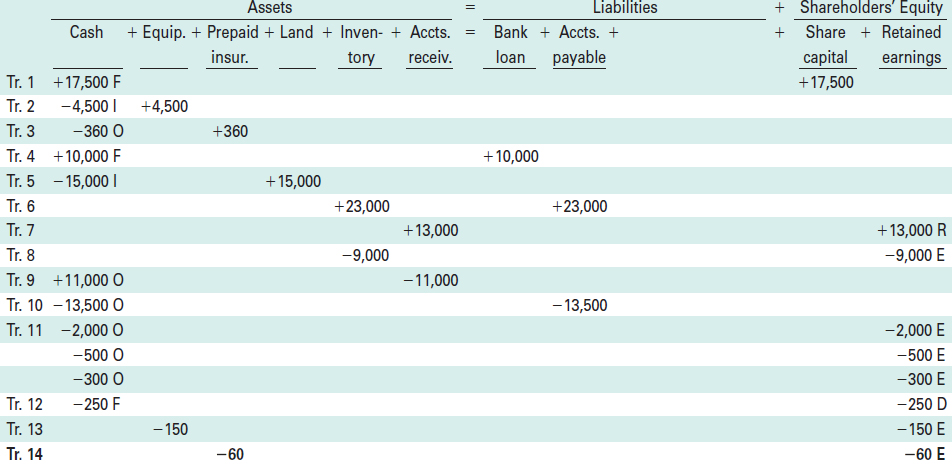
CASHFLOW EFFECT This transaction is similar to the preceding one, and has no effect on cash. The cash outflow for the insurance was shown when the asset was purchased. During each period of the asset's life, adjustments such as this are made to transfer a portion of the cost of the insurance from the asset account to an expense account; these adjustments do not involve cash.
EARNINGS EFFECT Notice that the deduction under retained earnings has an E beside it, indicating that this is an expense which will be reported on the statement of earnings for January.
You should also note that the balance in the prepaid insurance account will now be the correct amount as of the end of January ($300, representing five remaining months of insurance coverage), because when we recorded Transaction 3 we added $360 to the prepaid insurance column and in this transaction we deducted $60 from it.
RELATED CONCEPTS—The matching principle The initial handling of prepaid expenses as assets is dictated by the accrual basis of accounting and the principle of matching expenses with revenues in the proper accounting periods. In this case, although the cash payment for the insurance is made in January, we cannot classify the entire $360 as an expense of that month. Rather, the cost must be spread over the six-month period of the insurance coverage. As each month goes by, one-sixth of the insurance cost must be transferred to an expense account.
Exhibit 2-1 shows a timeline illustrating the effects of a prepaid expense and the timing issue involved. Part of the cost will be an expense on the statement of earnings in the current period, and the remaining portion will be an asset carried forward on the statement of financial position into the following period.
EXHIBIT 2-1 PREPAID EXPENSES: General Model
Exhibit 2-2 illustrates how the general concepts related to prepaid expenses are applied to the specific case of Demo's insurance policy.
EXHIBIT 2-2 PREPAID EXPENSES: Insurance Example
Transaction 15: Interest Expense
Interest expense has to be recognized for the month of January. The interest rate on the bank loan (which originated in Transaction 4) is 6% per year, and interest payments are to be made quarterly (i.e., at the end of every three months).
ANALYSIS Interest is the amount charged by lenders for the use of their money. From the borrower's point of view, interest is an expense and therefore results in a decrease in the shareholders' equity during the period when it is incurred. By the end of January, the $10,000 loan has been outstanding for one month; therefore, one month's interest expense should be recognized. Since Demo has not yet paid the interest (and will not pay it until the end of March), it has to recognize a liability now for its obligation to pay the interest later. This is an example of an accrued expense: a cost that has been incurred but not yet paid.
To calculate the amount of interest expense each period, you multiply the amount of the loan (known as the principal) by the interest rate and then by the fraction of the year that has passed (since the interest rate is always expressed as a yearly rate). In Demo's case, the amount of interest incurred in January is $10,000 × 6% × 1/12 = $50. The shareholders' equity (retained earnings) will therefore be decreased by $50, to recognize the interest expense, and a liability (interest payable) will be increased by $50, to recognize the obligation to pay the interest when it is due at the end of the quarter.
The analysis of this transaction and its effects on the basic accounting equation are summarized below:
ANALYSIS OF TRANSACTION 15
Shareholders' Equity (specifically, Retained Earnings) decreased by $50
Liabilities (specifically, Interest Payable) increased by $50
CASHFLOW EFFECT This transaction does not affect cash. Because the interest on this loan is only paid quarterly, the effect on cash will not occur until the end of the quarter.
EARNINGS EFFECT Even though it has not been paid, the interest on the loan is an expense and will be reported on the statement of earnings for the month of January. Accordingly, the amount deducted in the retained earnings column has an E beside it.
EFFECTS ON THE BASIC ACCOUNTING EQUATION
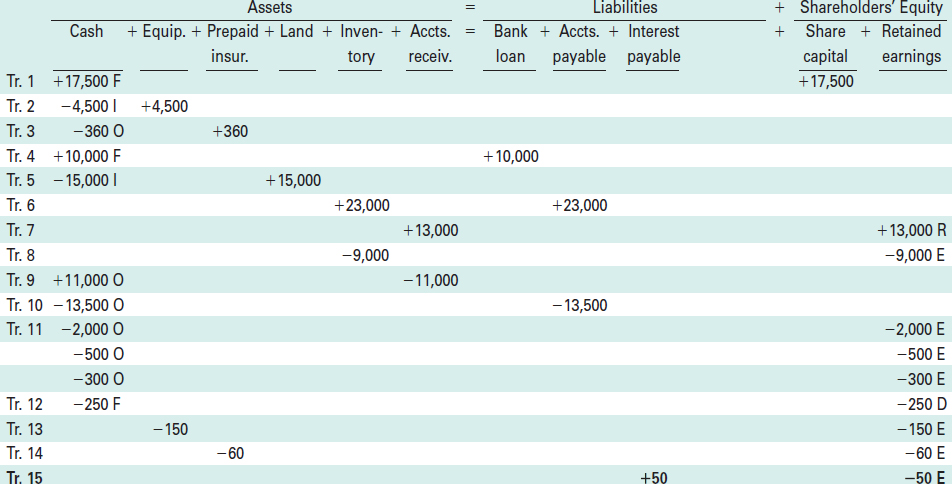
RELATED CONCEPTS—Accrued expenses Accrual-basis accounting requires that expenses be recognized in the period when they are incurred, rather than when they are paid. This is so they appear on the statement of earnings in the appropriate period and are matched against the revenues that they help to generate. Accrued expenses therefore result in liabilities that appear on the statement of financial position at the end of the period, representing the expenses that have been incurred by that date and will be paid at a future date.
Exhibit 2-3 illustrates how accrued expenses are recognized on the statement of earnings in the period when they are incurred, and result in a related liability on the statement of financial position until they are paid in a future period.
EXHIBIT 2-3 ACCRUED EXPENSES: General Model
Exhibit 2-4 illustrates how the general concepts related to accrued expenses are applied to the specific example of the interest on Demo Company's loan.
EXHIBIT 2-4 ACCRUED EXPENSES: Interest Example
Transaction 16: Income Tax Expense
Income tax expense must be recognized each accounting period, even though the company does not have to pay the tax until later. Demo's income tax rate is 25%.
ANALYSIS Businesses that are incorporated, such as Demo Company Limited, must pay taxes on the income they earn. This income tax is an expense of doing business in Canada, and therefore must be recognized on the company's statement of earnings. In addition, if the tax has not yet been paid, the amount owed must be reported on the statement of financial position as a liability. This is another example of an accrued expense (i.e., a cost of operating the business that has been incurred but not yet paid).
Like any expense, income tax expense reduces the shareholders' equity (because it reduces the company's net earnings, and hence its retained earnings). If the tax were paid immediately, the company's assets (in the form of cash) would be reduced. In this case, however, the company will not pay the tax until later; therefore, its cash is not affected at this time, but its liabilities are increased (in the form of income tax payable).
In order to calculate the amount of income tax expense, we need to first determine the company's income before tax. This can be done quite easily by examining the retained earnings column in the table we have been constructing, and subtracting the expenses from the revenue. Since revenue minus expenses equals income, this calculation will give us the amount of income before tax.
To illustrate this process for Demo Company, refer to the table on page 98 that shows the effects of all the preceding transactions on the basic accounting equation. The retained earnings column lists revenue of $13,000 and expenses of $9,000, $2,000, $500, $300, $150, $60, and $50. Note that dividends are not an expense, and are therefore not included in this calculation. By subtracting the expenses from the revenue, Demo's income before tax is found to be $940 (i.e., 13,000 − 9,000 − 2,000 − 500 − 300 − 150 − 60 − 50 = 940). Applying the income tax rate of 25% to this amount, Demo's income tax expense is found to be $235 (i.e., 0.25 × 940 = 235).
The analysis of this transaction and its effects on the basic accounting equation are summarized below:
ANALYSIS OF TRANSACTION 16
Shareholders' Equity (specifically, Retained Earnings) decreased by $235
Liabilities (specifically, Income Tax Payable) increased by $235
CASHFLOW EFFECT This transaction does not affect cash. The effect on cash will occur later, when the income tax liability is paid.
EARNINGS EFFECT The income tax that will have to be paid for January is an expense and will be reported on the statement of earnings for the month. Accordingly, the amount deducted in the retained earnings column has an E beside it.
RELATED CONCEPTS—The accrual basis of accounting As stated earlier, the accrual basis of accounting requires that expenses be recognized in the period when they are incurred so they appear on the statement of earnings in the appropriate period. This means that even if a company does not have to pay its income tax until later, it must still record the income tax expense that has been incurred during the current accounting period. At the same time, cash will be reduced for any portion of the tax that is paid, and a liability will be recorded for any portion of it that will be paid later. This accrual process ensures that the tax expense appears on the statement of earnings in the period that it relates to, and that a tax liability for the amount owing appears on the statement of financial position at the end of that period. Doing this enables the financial statements to present a true picture of the company's economic performance and financial position.
Although profit-oriented companies have long adhered to these requirements, governments have been slower to move to the accrual basis of accounting, as the following report illustrates.
This completes the analysis of the transactions of Demo Company Limited, for the month of January. Exhibit 2-5 shows the combined effects of these transactions on the basic accounting equation, and the resulting account balances at the end of January.
accounting in the news
Accrual-based Accounting in the Federal Government

Since 2003, the Canadian government has presented its financial statements using the full accrual basis of accounting. The move to full accrual accounting from the previous standard of “modified accrual accounting” shifted the focus of financial reporting from expenditures (recorded when funds are spent) to expenses (recorded when resources are used). This change resulted in the recording of tens of billions of dollars in additional assets and liabilities in the country's financial statements, including:
- inventories and prepaid expenses
- capital assets such as land, buildings, ships, and aircraft
- taxes receivable and taxes payable
- liabilities for pension plans for employees and veterans, as well as for health, dental, disability, and worker's compensation benefits
- liabilities related to such items as the cleanup of contaminated military sites, obligations under capital lease arrangements, and additional liabilities for Aboriginal claims
Prior to 2003, these items did not appear on Canada's statement of financial position, or balance sheet. Instead, they were charged against the annual surplus or deficit in the year the assets were acquired, the cash was received, or the liabilities were paid.
The Finance Department reports that the adoption of full accrual accounting provides a more complete measure of the government's financial position. It also reduces the distortions that arise through the timing of cash receipts and payments, and it properly allocates the costs of expensive capital items over the periods of their use, rather than simply the period when they were acquired. The result is a better estimation of the costs of government programs from year to year.
Source: Finance Canada
Note that, because this is a new company, the beginning balances in all the accounts are zero. However, if a company has account balances from previous periods it is essential to include them, because the statement of financial position totals must be cumulative.
Exhibit 2-5 provides all the information required to prepare Demo's financial statements: the statement of earnings, the statement of financial position, and the statement of cash flows. We will now look at each of these.
EXHIBIT 2-5 EFFECTS OF DEMO COMPANY'S TRANSACTIONS IN JANUARY 2011 ON THE BASIC ACCOUNTING EQUATION
LEARNING OBJECTIVE 7
Prepare a simple set of financial statements, reflecting a series of business transactions.
FINANCIAL STATEMENTS
Statement of Earnings
If necessary, you should refer to Chapter 1 for a description of the statement of earnings.
The statement of earnings can be constructed from the information recorded in the retained earnings column in Exhibit 2-5. Since we labelled each of the amounts that affected retained earnings with an R to indicate a revenue, an E to indicate an expense, or a D to indicate dividends, this will be an easy task. Each of the revenue and expense items in the retained earnings column of Exhibit 2-5 has to be reported on the statement of earnings.
In its simplest form, the statement of earnings would be presented as follows. While it would normally be prepared on a comparative basis, because this is Demo's first month of operations there are no figures from previous periods for comparison.
DEMO COMPANY LIMITED
STATEMENT OF EARNINGS
FOR THE MONTH ENDED JANUARY 31, 2011
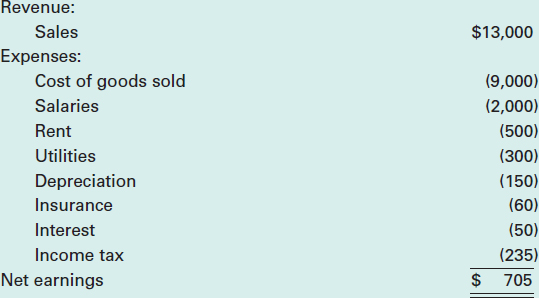
There are many other ways to organize and present the information on the statement of earnings; however, the net result would be the same. There is a detailed discussion of the statement of earnings and its alternative formats in Chapter 4.
Note that, because they are not an expense, dividends do not appear on the statement of earnings. Rather, they are a distribution of a portion of the earnings to the shareholders, and therefore affect retained earnings. The combination of the income earned and the dividends declared during the period explains the change in retained earnings, as follows:

Statement of Financial Position
At the bottom of Exhibit 2-5, you can see the net result of Demo's January transactions. These figures represent the amounts that should appear on the company's statement of financial position at the end of the month. However, the table presented in Exhibit 2-5 is not a statement of financial position. Although the same ending balances from Exhibit 2-5 will be shown on the statement of financial position, we have to reorganize the data and present it in a more formal manner.
The statement of financial position could be presented as shown below. Like all the financial statements, the statement of financial position would normally be prepared on a comparative basis; however, this being Demo's first month, there are no comparative figures.
Notice that the equipment is first shown at its original cost of $4,500; then the portion that has been written off (i.e., the $150 of depreciation that has been charged to date) is deducted, leaving the remaining amount of $4,350. This net amount is usually referred to as the asset's book value or carrying value.
You should also note that Demo's statement of financial position is indeed balanced; that is, the company's total assets are equal to the sum of its liabilities and shareholders' equity (as they must be, to satisfy the basic accounting equation).
DEMO COMPANY LIMITED
STATEMENT OF FINANCIAL POSITION
JANUARY 31, 2011
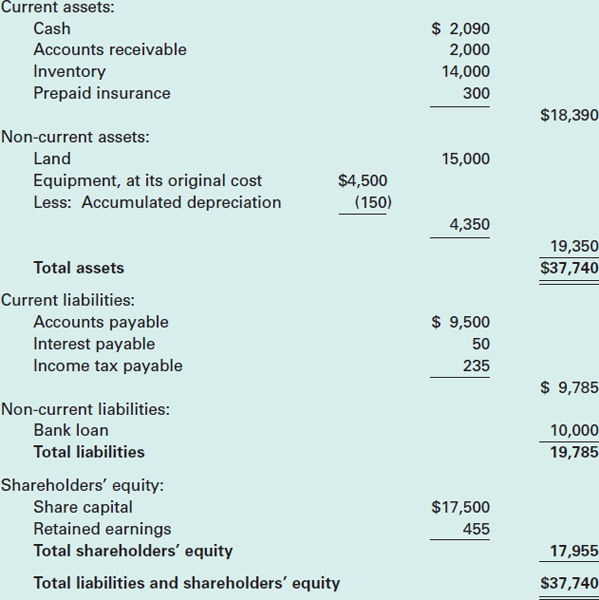
This is a classified statement of financial position, which means that the assets and liabilities have been categorized as current and non-current.
LEARNING OBJECTIVE 8
Explain the basic classification of items on a statement of financial position.
As you may recall from Chapter 1, current assets include short-term items such as cash, accounts receivable (that will be converted to cash within a year), and inventory and prepaid expenses (that will be sold or consumed within a year). Within the current assets section, the individual items are generally listed in the order of their liquidity—i.e., how quickly they can be converted into cash. Thus, the most liquid current assets, cash and accounts receivable, are listed first, followed by inventory and then items such as prepaid expenses (the least liquid).
Assets that will last more than one year, such as land and equipment, are classified as non-current assets. Within the non-current assets section, the items are typically listed in order of permanency, starting with the assets with the longest lives. Thus, land will usually be listed first, followed by buildings, and then equipment, vehicles, and so on—based on the length of time these assets will be useful to the company.
Current liabilities are short-term obligations that will be paid within one year, such as accounts payable and accrued liabilities. Since Demo's bank loan is not due to be repaid for five years, it is classified as a non-current liability. Within the liabilities, the individual items are generally listed according to how quickly they will require the use of cash. Those that will become due soonest are usually listed first; those with the longest durations are typically listed last. However, there is no firm requirement; the items can be listed in whatever order the company thinks is most informative.
Variations in Statement of Financial Position
Although the statement of financial position always has separate sections for assets, liabilities, and shareholders' equity, there are many variations in how these can be presented. For example, in the sequence of the items on the statement of financial position typical European practice is the opposite of that in North American practice. This was first discussed in Chapter 1, when we looked at H&M's balance sheet. For another example, look at the consolidated balance sheet or statement of financial position for the Lindt & Sprüngli Group, which is reproduced in Part A of Exhibit 2-6. (You might be familiar with some of this company's chocolate products, marketed under the Lindt brand.)
Notice that, on Lindt & Sprüngli's balance sheet, the assets section begins with the non-current assets, followed by the current assets. On the other side of its balance sheet, the liabilities and shareholders' equity sections are reversed; shareholders' equity is shown before the liabilities. Within the liabilities section, the non-current liabilities are listed first, then the current liabilities.
HMV Group uses another variation in format for its balance sheet. Notice in Part B of Exhibit 2-6 that, after HMV lists its assets and liabilities (with, in both cases, the non-current items before the current items), it subtracts the total liabilities from the total assets to get the net assets. It then lists the shareholders' equity and shows that the total equity is equal to the net assets. (From the basic accounting equation, Assets = Liabilities + Shareholders' Equity, we know that Assets − Liabilities = Shareholders' Equity. Since, by definition, Net Assets = Assets − Liabilities, the shareholders' equity must be equal to the net assets.)
In conclusion, it is the content of the financial statements that is important, not the order of the items within them. Any format that is meaningful to the users is acceptable.
USING RATIOS TO ANALYZE FINANCIAL STATEMENTS
The statement of earnings shows that Demo Company operated profitably during the month of January, with net earnings of $705. By itself, however, knowing that the income was $705 tells users very little. To understand a company's profitability more fully, users will often use ratio analysis, which you will see frequently throughout this text.
EXHIBIT 2-6A EXAMPLES OF DIFFERENCES IN STATEMENT OF FINANCIAL POSITION PRESENTATION: Lindt & Sprüngli Group 2009 ANNUAL REPORT
EXAMPLES OF DIFFERENCES IN STATEMENT OF FINANCIAL POSITION PRESENTATION: Lindt & Sprüngli Group 2009 ANNUAL REPORT
 EXHIBIT 2-6B EXAMPLES OF DIFFERENCES IN STATEMENT OF FINANCIAL POSITION PRESENTATION: HMV Group 2009 ANNUAL REPORT
EXHIBIT 2-6B EXAMPLES OF DIFFERENCES IN STATEMENT OF FINANCIAL POSITION PRESENTATION: HMV Group 2009 ANNUAL REPORT
A ratio divides one financial statement amount by another, so that users can compare related amounts. As seen in the financial statements illustrated so far, meaningful relationships can be derived from many numbers. Ratios allow users to compare companies of different sizes, or to compare the same company's situation at various times. Ratio analysis can be used to assess things such as profitability, the effectiveness of management, and the company's ability to meet debt obligations. In Chapter 1, we discussed how the ratio of a company's total liabilities to its total liabilities plus shareholders' equity could be used to indicate how much a company relies on debt financing. As we introduce new topics, we will show additional ratios that can help users understand and evaluate a set of financial statements. In addition to this, Chapter 12 presents a complete discussion of these ratios.
We will now use Demo Company's financial statements to examine profitability ratios. Profitability ratios are usually constructed by comparing some measure of the company's profit (net income or earnings) to the amount invested, or by comparing the profit to the company's revenues. We will calculate three such measures.
LEARNING OBJECTIVE 9
Calculate three ratios for assessing a company's profitability.
Profitability Ratios
The profit margin ratio is calculated by dividing the company's profit (or income) by the revenues that produced the profit. For Demo Company, this ratio is calculated by dividing its $705 of net earnings by its $13,000 of sales revenue, giving a result of 0.0542. This indicates that Demo earned, as profit, 5.42% of the amount of its revenue. Stated another way, after the related expenses were deducted from the sales revenues that were generated by the company in January, 5.42% of the revenues remained with the company as income.
The return on assets is another measure of profitability. It is calculated by dividing the company's profit (or income) by its average total assets.
Like all the amounts on the statement of financial position, the amount for total assets is determined at particular points in time. For Demo, the relevant points in time are January 1 and January 31, 2011 (i.e., the beginning and end of the current accounting period). To get a measure of the total assets during the period between these two dates, we would normally calculate the average. However, since Demo had no beginning balances for January, the average amount would not be very meaningful in this situation. Therefore, we will simply use the amount for total assets at the end of the period.
In January 2011, Demo's return on assets was its $705 of net earnings divided by its $37,740 of total assets, giving a result of 0.0187 or 1.87%. Remember that a company's reason for having assets is to use them to generate profits. Demo's return on assets of 1.87% means that during its first month of operations it earned profit at the rate of $1.87 for each $100 that was invested in its assets.
The third measure of performance is the return on equity. This ratio compares the return (or income) earned to the amount invested by the shareholders, represented by the total shareholders' equity. (Again, we would normally calculate the average shareholders' equity. However, an average amount would not be very meaningful for the month of January, because it was the company's first period of operations and the beginning balances were zero. Therefore, we will simply use the amount for total shareholders' equity at the end of January.)
The return on equity for Demo during January is then calculated by dividing its $705 of net earnings by its $17,955 of shareholders' equity, giving a result of 0.0393, or 3.93%. This measure shows that in the month of January Demo's shareholders earned a 3.93% return on their investment in the company. It also means that during its first month of operations the company earned profit at the rate of $3.93 for each $100 that was invested by the owners.
Ratios are most useful when they are compared to the company's past performance, or with other companies in the same industry. Chapter 12 provides an extensive discussion of these and other ratios and how to interpret them.
Statement of Cash Flows
A statement of cash flows will now be constructed, using the information in the cash column in Exhibit 2-5. The statement of cash flows explains the changes in the amount of cash, by detailing the company's operating, financing, and investing activities (as described in Chapter 1).
Remember that, to make it easier to prepare this statement, we marked all the cash transactions in the exhibit with an O to indicate an operating activity, an F to indicate a financing activity, or an I to indicate an investing activity. All that we need to do now is arrange the items under these three headings and present the data in a more formal manner, as follows.
DEMO COMPANY LIMITED
STATEMENT OF CASH FLOWS
FOR THE MONTH ENDED JANUARY 31, 2011
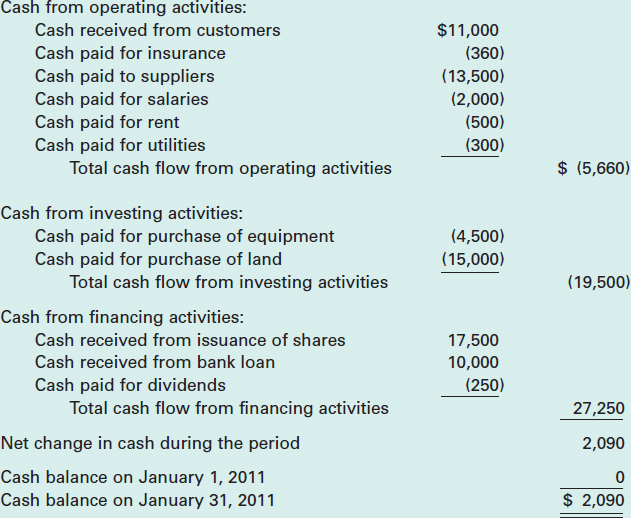
Note that the final amount shown above is what is shown for cash on the statement of financial position.
You might have noticed that the operating activities section of Demo's statement of cash flows is somewhat different from H&M's, which was shown in Exhibit 1-5. The reason is that GAAP allows this section to be presented using either a direct or an indirect method. The direct method has been used here, whereas the indirect method is used by H&M. Chapter 5 will explain this difference and provide a detailed discussion of the statement of cash flows.

Generally speaking, with regard to interpreting a statement of cash flows, when you look at its three main sections you should bear in mind that
LEARNING OBJECTIVE 10
Begin to analyze the information provided by a statement of cash flows.
- operating activities are normally expected to generate a net inflow of cash
- investing activities are normally expected to result in a net outflow of cash
- financing activities are normally expected to result in a net inflow of cash
In Demo Company's case, notice that the statement of cash flows shows that there was a net cash outflow from its operating activities, even though its operations in January were profitable (as indicated by the statement of earnings). The other two sections of Demo's statement of cash flows conform to what would normally be expected: its investing activities resulted in a net cash outflow, and its financing activities resulted in a net cash inflow.
As the only really obvious cause for concern is the negative cash flow from operating activities, we would want to examine why Demo Company is experiencing this cash drain even though it is profitable. Although it is not unusual for a new business to have a negative cash flow from operations during its early stages, it should be clear that a company cannot continue to operate indefinitely with its day-to-day operations consuming cash, rather than generating it. In fact, cash flow problems are why many new businesses fail in their first year.
Analyzing why a company is having difficulty generating cash from its operating activities is beyond the scope of this chapter, but Demo's situation represents an important issue that will be addressed in various sections of this book, particularly in Chapter 5. For now, it is important to understand that, while the statement of earnings provides important information about a company's performance, it does not reveal everything that should be known about the period's activities. The statement of cash flows provides additional useful information about the company's operations that is not provided by the statement of earnings.
SUMMARY
This chapter introduced the process for recording transactions in an accounting system, using the basic accounting equation to analyze the effects of various events. A set of business transactions was examined in detail, and the effects of these transactions on the basic accounting equation were illustrated. Related concepts and underlying accounting principles were also discussed. Based on an analysis of how a series of transactions affected the basic accounting equation, the three main financial statements were developed.
The explanations that accompanied the transactions and financial statements in this chapter built on the information provided in Chapter 1. In the next chapter, we will continue the Demo Company example and use it to illustrate, in a more formal manner, how the accounting system works.
You should carefully work through the following problem, and then check your work against the suggested solution. Doing this problem will reinforce and extend what you have learned in this chapter.
Exhibit 2-7 shows the statement of financial position of Sample Company Ltd.
EXHIBIT 2-7

Additional Practice Problems
The following transactions occurred during 2011:
- Additional inventory was purchased for $39,700 on account.
- Goods with selling prices totalling $80,000 were sold, all on account.
- The company received $78,400 from customers as payments on accounts receivable.
- The company paid $37,300 to suppliers on its accounts payable.
- The cost of the goods that were sold during the year totalled $38,200.
- Additional shares were sold to investors for $4,000 cash.
- New equipment was purchased for $5,000 cash during the year.
- Dividends of $1,500 were declared and paid during the year.
- Employees earned salaries for the year totalling $20,500. (Hint: The next transaction deals with the payment of salaries. Therefore, at this point the salaries should be recorded as payable.)
- Cash payments for salaries during the year totalled $20,800.
- The rent for each month was always prepaid on the last day of the previous month. Accordingly, a payment of $1,000 had been made on December 31, 2010, for the rent for the month of January 2011. The rent payments during 2011 were $1,000 per month from January 31 through November 30, and $1,200 on December 31 (because the rent was increased for 2012). (Hint: Record the payments as prepaid rent, initially; then, as a separate transaction, transfer the cost for the year 2011 to rent expense.)
- Interest on the bank loan, at 8%, was paid on December 31, 2011. At the same time, $400 of the loan principal was repaid.
- Depreciation expense on the company's equipment totalled $2,000 for the year.
- The income tax rate is 30%. Tax payments of $1,900 were made during the year.
Required
- Analyze the effects of each of the transactions on the company's accounts, using the basic accounting equation (as illustrated in this chapter).
- Use your answer for part “a” of this problem to prepare a statement of earnings, statement of financial position, and statement of cash flows.
- Calculate the following ratios for the year 2011:
- Profit margin ratio
- Return on assets
- Return on equity
STRATEGIES FOR SUCCESS:
- Start by setting up a table, such as the one that was constructed in this chapter. Use the account titles from the statement of financial position (given in Exhibit 2-7) as the column headings. Enter the beginning balances as the first line of data in the table.
- Begin your analysis of each transaction by thinking about what items are affected by it, bearing in mind that there must be at least two. Then determine whether each of those items is increasing or decreasing, and enter the effects in the table.
- As you enter the effects of each transaction, ensure that the basic accounting equation remains balanced (i.e., Assets = Liabilities + Shareholders' Equity).
- Watch for key words such as “collected,” “received,” or “paid,” indicating that cash has increased or decreased. On the other hand, “on account” means that the collection, receipt, or payment will occur later; in the meantime, an account receivable or account payable will exist.
- Remember that revenues have to be earned by selling goods or services. Issuing shares in the company does not generate revenue, because the money that comes in has not been earned by operating the business; it has simply been invested by the owners. Similarly, collecting accounts receivable from customers does not generate revenue; the revenue is earned and recorded when the goods are sold, not when the accounts are collected.
- Be careful to distinguish between expenses and assets. Expenses are costs that have been used up or consumed in the process of operating the business and generating revenues; assets are costs that have not yet been consumed and can be used to operate the business and generate revenues in the future.
SUGGESTED SOLUTION TO PRACTICE PROBLEM
The basic accounting equation analysis (part “a” of the problem) is shown in Exhibit 2-8. The entries are numbered to match the transaction numbers in the problem. The financial statements (required for part “b”) are shown in Exhibits 2-9, 2-10, and 2-11. Following these, the ratios (required for part “c”) are presented.
EXHIBIT 2-8 ANALYSIS OF TRANSACTIONS: Sample Company Ltd.
Explanations follow for selected transactions:
Transactions 9 and 10: Salaries
The amount of salaries earned by employees during the period should be shown as an expense for the company. The amount of salaries paid during the period reflects the payment of salaries from the previous period (i.e., the beginning balance in the accrued salaries payable account), as well as partial payment of salaries for the current period. The ending balance in the salaries payable account reflects salaries that have been earned by employees during the current period but have not yet been paid.
Transaction 11: Rent
There were 12 rent payments during 2011: the first 11 were for $1,000 each, and the last was for $1,200. (11 × $1,000) + (1 × $1,200) = $12,200
The rent expense for 2011 is calculated differently, however. The beginning balance in prepaid rent reflects the payment that was made on December 31, 2010, for January 2011. This plus the amounts paid for the other 11 months of 2011 constitute the rent expense for the year. In other words, the rent expense is the expired cost for January through December 2011: 12 months × $1,000 per month = $12,000.
The final payment of $1,200 on December 31, 2011, applies to the first month of 2012 and is, therefore, an asset at the end of 2011. This appears as the ending balance in the prepaid rent account.
Transaction 12: Interest
Because the interest expense was paid during the year, there is no accrued liability at the end of the period. The cash payments for interest, in this case, are the same as the expense. The expense is calculated by multiplying the principal ($3,500) by the interest rate (8%) for one year.
Note that repaying the principal of a loan does not create an expense; it simply reduces the loan liability. The expense related to the loan is the interest charged on it.
Although it would seem logical to view an interest payment as a financing cash flow, most companies treat the payment of interest as an operating cash flow. Accordingly, in this book we will classify interest payments as operating activities. You should be aware, however, that some companies classify interest payments as financing activities.
Transaction 14: Income tax
To determine the tax expense for the period, the amount of income before tax must first be determined. This is found by subtracting the expenses from the revenues, all of which are listed in the retained earnings column in Exhibit 2-8. Thus, the income before tax is $7,020 (i.e., 80,000 − 38,200 − 20,500 − 12,000 − 280 − 2,000 = 7,020). Since Sample Company's tax rate is 30%, its income tax expense is then calculated by taking 30% of its income before tax, resulting in $2,106 (i.e., 0.30 × 7,020 = 2,106).
The beginning balance in the income tax payable account was tax owing from 2010 that was paid in 2011. The ending balance in the tax payable account will be paid in 2012.
The amounts on the statement of earnings are the ones designated with either an R or an E (indicating Revenue or Expense) in the retained earnings column of Exhibit 2-8.
EXHIBIT 2-9
The amounts reported on the statement of financial position for 2011 are simply the ending balances from Exhibit 2-8.
Note that the ending balance for retained earnings equals the beginning balance plus the net earnings minus the dividends declared (i.e., $6,500 + 4,914 − 1,500 = $9,914).
The amounts reported on the statement of cash flows are those in the cash column of Exhibit 2-8, each of which was designated O, I, or F (indicating an Operating activity, Investing activity, or Financing activity).
Note that the ending balance reported on the statement of cash flows agrees with the cash balance reported on the statement of financial position at the end of 2011.

Note that we have calculated the average total assets and the average total shareholders' equity, to get amounts that are representative of the entire year.
SYNONYMS
Amortization ![]() Depreciation
Depreciation
Book value ![]() Carrying value
Carrying value
Credit purchase ![]() Purchase on account
Purchase on account
Credit sale ![]() Sale on account
Sale on account
Earnings ![]() Income/Profit
Income/Profit

GLOSSARY
Accounts payable Liabilities that result when inventory or supplies are purchased on credit. They represent an obligation to pay cash to suppliers in the future.
Accounts receivable Assets that result when goods or services are sold on credit. They represent the right to receive cash from customers in the future.
Accrual basis The accounting basis, used by almost all companies, that recognizes revenues and expenses in the period when they are earned or incurred, and not necessarily in the period when the related cash inflows and outflows occur.
Accrued expense An expense that has been incurred and reported on the statement of earnings, but not yet been paid for; consequently, a related liability is reported on the statement of financial position.
Amortization A synonym for depreciation.
Book value The value carried in the accounting system (or “on the company's books”) for an item. A synonym for carrying value.
Carrying value A synonym for book value.
Cash basis The accounting basis, used by some entities, that recognizes revenues and expenses when the cash inflows or outflows occur.
Classified statement of financial position A statement of financial position in which the assets and liabilities sections are subdivided into current (or short-term) and non-current (or long-term) items.
Contra-asset An account whose balance is offset against, or deducted from, a related asset.
Cost of goods sold The expense that records the acquisition value of the inventory that was sold during the period.
Credit purchase A business transaction in which a buyer acquires goods or services from a seller in exchange for the buyer's promise to pay cash at a later date. This is also referred to as a purchase on account, because it creates an account payable on the buyer's books.
Credit sale A business transaction in which a seller provides goods or services to a buyer in exchange for the buyer's promise to pay cash at a later date. This is also referred to as a sale on account, because it creates an account receivable on the seller's books.
Current assets Short-term assets that will generally be converted into cash or consumed within one year.
Current liabilities Short-term debts or obligations that will be settled within one year.
Depreciation The expense that records the usage of a non-current asset, such as equipment, for the period. Depreciation is a process that allocates the cost of a non-current asset to each of the periods in the asset's useful life. Depreciation is sometimes referred to as amortization.
Dividends declared A distribution of assets (usually cash) to the shareholders of a company. The board of directors votes to declare the distribution, at which point it becomes a legal obligation of the company. The distribution of cash occurs at a date specified at the time of declaration.
Historical cost A valuation method that values assets at the amounts that were paid to obtain them.
Liquidity A quality of an asset that describes how quickly it can be converted into cash. Assets that can be converted into cash quickly have high liquidity.
Loss A reduction in shareholders' equity that results when the value of the resources that flowed into the company (i.e., revenues) are less than the value of the resources that flowed out (i.e., expenses). A net loss is the opposite of net earnings, income, or profit.
Matching concept A concept in accounting that requires all expenses related to the production of revenues to be recorded during the same time period as the revenues. The expenses are said to be matched with the revenues on the statement of earnings.
Net assets Total assets minus total liabilities. Mathematically, the net assets must equal the shareholders' equity.
Non-current assets Assets that will last and provide future benefits for more than one year.
Non-current liabilities Debts or obligations that will not be settled within one year.
Note payable A liability represented by a formal document that states the amount owed to a creditor. It is similar to an account payable, except that the note constitutes legal documentation that the buyer has promised to make payment in the future. The note usually specifies the amount, due date, and interest rate.
Note receivable An asset represented by a formal document that states the amount due from a customer. It is similar to an account receivable, except that the note constitutes legal documentation that the seller has the right to receive payment in the future. The note usually specifies the amount, due date, and interest rate.
Prepaid expense An asset representing a past expenditure whose benefits are expected to be consumed in a future accounting period. A prepaid expense represents a past cash outflow for which the company will receive future economic benefits. It is sometimes called a deferred expense.
Principal The amount of a debt, excluding interest.
Profit A synonym for earnings or income.
Profit margin ratio A ratio that compares the net earnings (or profit or income) during an accounting period to the related revenues.
Purchase on account A purchase in which the buyer gives a promise to the seller to pay at a later date. A synonym for credit purchase.
Residual value The estimated value of an asset at the end of its useful life. The estimate is made when the asset is purchased, in order to calculate the amount to be depreciated each period.
Return on assets A ratio that compares the net earnings (or income or profit) for the period to the company's assets.
Return on equity A ratio that compares the net earnings (or income or profit) for the period to the share-holders' equity in the company.
Revenue recognition criteria Conditions that must be satisfied for revenues to be recognized in the accounting system.
Sale on account A sale in which the seller receives a promise from the buyer to pay at a later date. A synonym for credit sale.
Sales revenue The amount of sales recognized and reported on the statement of earnings during the accounting period, based on the revenue recognition criteria.
Straight-line depreciation A method of calculating depreciation in which the amount of expense for each period is found by dividing an asset's cost (less any residual value) by its estimated useful life.
Transaction An exchange of resources with an outside entity, or an internal event that affects the balances in individual asset, liability, or shareholders' equity accounts.
Transaction analysis The process by which an accountant decides what accounts are affected, and by how much, when an economic transaction or event occurs.
Useful life The estimated period of time over which a capital asset (such as equipment) is expected to be used.

Self-Assessment Quiz
ASSIGNMENT MATERIAL
Assessing Your Recall
2-1 Explain the difference between an asset and a liability.
2-2 Describe how the basic accounting equation (or balance sheet equation) is used to analyze how transactions are recorded in the accounting system.
2-3 Discuss why dividends do not appear on the statement of earnings but do appear on the statement of cash flows.
2-4 What are the advantages and disadvantages of using the accrual basis of accounting rather than the cash basis?
2-5 Identify the three major sections in the statement of cash flows, and briefly describe the nature of the items that appear in each section.
2-6 Indicate whether each of the following statements is true or false:
- The cash basis of accounting recognizes revenues when they are received.
- In the cash basis of accounting, there is no such thing as a prepaid rent account.
- In the accrual basis of accounting, paying an account payable creates an expense.
- In the accrual basis of accounting, interest should be recognized only when it is paid.
- Cash receipts from customers increase accounts receivable.
- Expenses increase shareholders' equity.
- Dividends are an expense of doing business and should appear on the statement of earnings.
- Interest paid on bank loans is reported in the investing activities section of the statement of cash flows.
2-7 What are revenue recognition criteria, and how does the matching concept relate to these criteria?
2-8 Explain how a prepaid expense (such as rent) is handled under accrual-basis accounting.
2-9 Explain how an accrued expense (such as interest) is handled under accrual-basis accounting.
2-10 Explain what depreciation is, and how it is calculated using the straight-line method.
Applying Your Knowledge
2-11 (Determine missing amounts using financial statement relationships)
For the two independent cases that follow, determine the missing amount for each letter. (Hint: You might not be able to calculate them in the order in which they appear.)
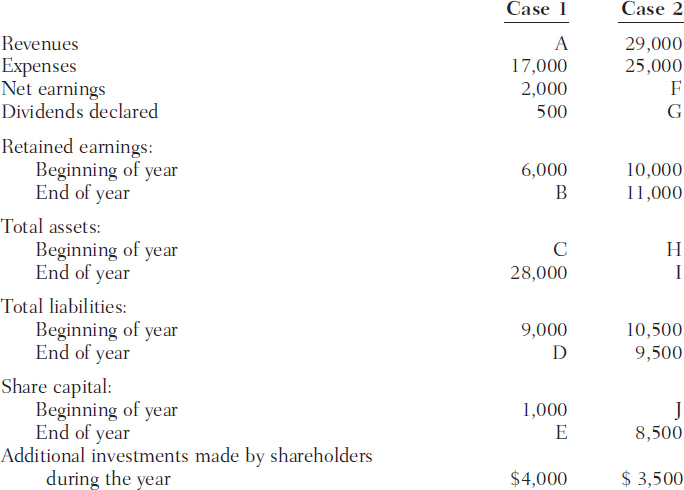
2-12 (Determine net earnings or loss from statement of financial position changes)
The following are from a company's statements of financial position:

During 2011, the company issued additional shares for $7,000 and declared dividends of $4,000.
Calculate what the company's net income or loss must have been for the year 2011. Be sure to indicate whether your answer represents net earnings or a net loss.
2-13 (Determine revenues, expenses, and dividends)
The following information for the current year was obtained from the accounting records of Safari Supplies Corporation:
| Retained earnings, beginning | $ 96,000 |
| Retained earnings, ending | 105,600 |
| Sales | 448,800 |
| Cost of goods sold | 272,000 |
| Selling expenses | 63,300 |
| General and administrative expenses | 38,800 |
| Dividend revenue | 4,800 |
| Interest revenue | 2,200 |
| Interest expense | 1,200 |
| Income taxes expense | 26,400 |
Required:
Calculate the following items:
- Total revenues
- Total expenses
- Net earnings
- Dividends declared
2-14 (Determine statement of earnings and statement of financial position amounts)
Rhaman Company had the following transactions in its first month of operations:
- The owner invested $10,000 cash in the business, plus some office furniture and equipment that had originally cost her $3,000 but was currently worth only $1,000.
- Additional equipment costing $4,000 was purchased for cash.
- Supplies costing $500 were purchased for cash.
- Inventory costing $5,000 was acquired on account. Later in the month, the company paid half of the amount owed. It will pay the remainder next month.
- The entire inventory was sold to customers for $8,000. The company received half of this amount in cash and will receive the remainder next month.
- By the end of the month, $400 of the supplies were used up.
- The equipment was amortized $100 for the month.
- Operating expenses paid in cash during the month were $1,900.
- Dividends of $200 were declared and paid during the month.
Required:
- Calculate the following amounts for the month:
- Sales revenue
- Cost of goods sold
- Total expenses other than cost of goods sold
- Net earnings or loss
- Calculate the following amounts as of the end of the month:
- Cash on hand
- Total assets other than cash
- Total liabilities
- Share capital
- Retained earnings
2-15 (Cash basis versus accrual basis)
Based on the following transactions, calculate the revenues and expenses that would be reported (a) on the cash basis and (b) on the accrual basis:
- Credit sales to customers totalled $35,000.
- Cash sales totalled $115,000.
- Cash collections on account from customers totalled $30,000.
- Cost of goods sold during the period was $85,000.
- Payments made to suppliers of inventory totalled $75,000.
- Wages of $32,500 were paid during the year. In addition, wages of $2,500 remained unpaid at year end; there were no wages unpaid at the beginning of the year.
- Halfway through the year, a one-year insurance policy was purchased at a cost of $1,000.
2-16 (Cash basis versus accrual basis)
Based on the following transactions, calculate the revenues and expenses that would be reported (a) on the cash basis and (b) on the accrual basis:
- Inventory costing $70,000 was purchased on account.
- Inventory costing $60,000 was sold for $100,000. Eighty percent of the sales were for cash.
- Cash collected from credit customers (i.e., who bought on account) totalled $20,000.
- A lease was signed at the beginning of the year, requiring monthly payments of $1,000. The rent for the first month was paid when the lease was signed. After that, the $1,000 rent was paid on the last day of each month, to cover the following month.
- Office supplies costing $5,500 were purchased for cash. At the end of the year, $500 of the office supplies were still unused.
- Wages of $37,500 were paid during the year. Also, wages of $500 remained unpaid at year end.
2-17 (Nature of retained earnings)
Explain why you agree or disagree with the following statement: “Retained earnings are like money in the bank. If you are running out of cash, you can always use some of your retained earnings to pay your bills.”
2-18 (Statement of earnings and statement of cash flows)
Compare and contrast the purpose of the statement of earnings and the statement of cash flows. Outline how they differ, and briefly describe their relationship to the statement of financial position.
2-19 (Transaction analysis and the basic accounting equation)
For each of the following transactions, indicate the effect on the basic accounting equation (assets = liabilities + shareholder's equity):
- Issuance of shares for cash
- Purchase of land for cash
- Sale of services to a customer on credit
- Receipt of cash from customers as payments on their accounts
- Payment of cash to shareholders as a distribution of earnings
- Receipt of a loan from a bank
- Payment of interest on the bank loan
- Purchase of inventory on credit
- Payment of an account payable
- Payment to a courier company for delivering goods to a customer
- Payment of an insurance premium to cover the following year
- Depreciation of equipment
2-20 (Transaction analysis)
For each of the transactions below, indicate which accounts are affected and whether they are increased or decreased:
- Sold shares for cash.
- Borrowed money from a bank.
- Bought equipment from a supplier on credit.
- Bought inventory from a supplier, partly for cash and partly on account.
- Sold inventory to a customer on account. (Hint: Your answer should deal with both the revenue and the related expense.)
- Made a payment to a supplier on account.
- Received a payment from a customer on account.
- Bought office supplies for cash.
- Declared and paid a dividend.
- Accrued the interest on the money that was borrowed in transaction “b” (i.e., recognized the interest but did not pay it).
- Paid for the equipment that was purchased on credit in transaction “c.”
- Used some of the office supplies that were purchased in transaction “h.”
2-21 (Transaction analysis)
For each of the following transactions, indicate how (a) net earnings and (b) cash flows are affected. For each, state whether there will be an increase, a decrease, or no effect, and the amount (if any):
- Issued shares to investors for $60,000.
- Purchased inventory from suppliers for $2,500, on account.
- Sold a unit of inventory for $500, on account. The unit had cost $300 and was already in inventory prior to its sale.
- Purchased equipment for $10,000 cash.
- Made a payment of $1,000 on accounts payable.
- Used $300 of office supplies. The supplies were purchased for cash in an earlier period.
- Received a payment of $700 from a customer for inventory previously sold on account.
- Declared (but did not yet pay) a dividend of $2,000.
- Paid the $2,000 dividend that was declared above.
- Depreciated equipment by $500.
2-22 (Transaction analysis and the basic accounting equation)
Analyze the following transactions and show their effects on the basic accounting equation, by preparing a table like the one in Exhibit 2-8:
- Received $150,000 from investors buying shares in the company.
- Bought land for $50,000. Paid half in cash, with the remainder to be paid in six months.
- Bought inventory costing $45,000, on account.
- Sold inventory costing $35,000 to customers, on account, for $52,000.
- Paid $1,000 of taxes that were owed from the previous period.
- Borrowed $25,000 from a bank. The interest on the loan is 6% per year.
- Depreciated equipment by $1,200.
- Paid $750 for supplies to be used in the future.
- Paid $250 to the power company for electricity used during the period.
- Declared and paid dividends of $8,000.
2-23 (Transaction analysis and the basic accounting equation)
Dr. Walter Wong completed the following business transactions during the month of November:
- Incorporated a veterinary practice by investing (a) $30,000 in cash and (b) equipment worth $20,000.
- Rented a furnished office and clinic, and paid $1,500 in rent for the month of November.
- Purchased medical supplies on account, $850.
- Performed veterinary services and immediately collected $2,400 for the work.
- Paid for the medical supplies that were purchased in transaction c.
- Provided $700 of additional veterinary services, on account.
- Used $350 of the medical supplies that were purchased in transaction c.
- Received $500 in partial payment for the services that were provided in transaction f.
- Paid the November telephone bill for the office, $75.
- Received a bill of $250 for advertising, but decided not to pay it until next month.
- Paid rent on the office for the months of December and January, totalling $3,200.
- Dr. Wong paid $1,000 from the clinic's bank account for repairs to his vacation villa in Cuba. (Hint: Before recording it, think about the nature of this transaction and the definition of an expense.)
Required:
Analyze these transactions and show their effects on the basic accounting equation for November, by preparing a table like the one in Exhibit 2-8.
2-24 (Transaction analysis and the basic accounting equation)
Show how each of the following transactions affects the basic accounting equation (assets = liabilities + shareholders' equity), and identify the ones that have an immediate impact on the statement of earnings and/or the statement of cash flows:
- Bought parts and supplies inventory for $15,000, on account. (The company repairs and services vehicles, and will use these parts and supplies for repairs.)
- Paid $12,000 to suppliers for the purchases that were made in transaction “a.”
- Received $20,000 in cash for repairing and servicing vehicles; another $5,000 of work was done on account.
- Collected $3,000 from customers for the work that was done on account in transaction “c.”
- In the repair work done in transaction “c,” $10,000 of the parts and supplies inventory was used.
- The owners invested a further $25,000 in the business, and shares were issued to them.
- Received utility (electricity, water, and telephone) bills for the month that totalled $600. Paid all these bills except for $100 that will be paid next month.
- Borrowed $50,000 from the bank.
- Bought a vehicle hoist for $45,000.
- Paid the employees their wages for the month, $9,000.
- Recorded accrued interest of $200 on the bank loan. The interest will be paid when the loan is due, in one year.
- Some of the parts that were used in the repair of the vehicles have warranties. The company estimates that $500 in free replacements will be necessary in the future, under the terms of the warranties. (Hint: This is an expected future cost to the company. Remember that if revenue is recognized in the current period, the matching principle requires that all the associated expenses be recognized in the same accounting period.)
2-25 (Transaction analysis and the basic accounting equation)
For each of the following transactions, indicate (a) what the immediate effect will be on the basic accounting equation, and (b) what other effects, if any, there will be in the future as a result of the transaction:
- Sold inventory to customers for cash.
- Sold inventory to customers on account.
- Collected cash from customers as payments on their accounts.
- Purchased inventory on account.
- Paid suppliers for goods purchased on account.
- Purchased production equipment for cash.
- Paid for an insurance policy on an office building.
- Borrowed money from the bank.
- Bought a patent, which gives the company the exclusive right to use an improved production process.
- Provided warranties to customers for free repair or replacement of any defective products that were sold to them. (See transaction “l” in Problem 2-24 for more information about this type of transaction.)
2-26 (Transaction analysis and the basic accounting equation)
Show the effect of each of the following transactions on the basic accounting equation, by preparing a table like the one in Exhibit 2-8. The company's fiscal year end is December 31.
- On January 1, 2011, the company borrowed $15,000 from the bank.
- On December 31, 2011, the company paid the interest on the bank loan in transaction “a.” The interest rate is 6%.
- On January 1, 2011, the company bought equipment for $10,000 cash.
- On December 31, 2011, the company recorded depreciation on the equipment, using the straight-line method. The equipment has an estimated useful life of six years and an estimated residual value of $1,000.
- Purchases of inventory on account during the year totalled $87,500.
- Sales for the year totalled $147,500, of which $17,500 was for cash and the remainder was on account.
- The cost of the products sold from inventory during the year was $85,000.
- Payments to suppliers for inventory purchases totalled $73,000 during the year.
- Collections on account from customers totalled $116,000 for the year.
- Employees earned wages of $48,400 during the year, which were recorded as Wages Payable.
- All employee wages were paid by the end of the year except the wages for the last week in December, which totalled $1,200.
- Dividends were declared and paid in the amount of $1,000.
2-27 (Transaction analysis and the basic accounting equation)
Show the effect of each of the following transactions on the basic accounting equation, by preparing a table like the one in Exhibit 2-8. The fiscal year end of the company (which has been operating for several years) is December 31.
- Consumed $1,000 of office supplies during the year. The supplies were purchased for cash the previous year.
- Purchased $32,000 of inventory on account during the year.
- Made sales of $60,000 during the year, of which $24,000 were cash sales.
- Paid $36,000 owed to suppliers on accounts payable. (This included some amounts owed from the previous year.)
- Collected $34,000 due from customers on accounts receivable. (This included some amounts due from the previous year.)
- Paid an insurance premium of $800 on March 31 that provides coverage for the 12-month period starting April 1. The company had no insurance prior to this.
- Determined that the cost of the inventory sold during the year was $39,000. (This included some inventory purchased the previous year.)
- Paid $7,000 for operating expenses during the year.
- On December 31, the company recognized the amount of insurance expense incurred during the period. (Refer to transaction “f.”)
- Recorded $3,600 of depreciation for the year on the company's equipment.
- Declared (but did not immediately pay) dividends of $400 each quarter, for a total of $1,600.
- By the end of the year, $1,200 of the dividends were paid.
2-28 (Determine amounts using the basic accounting equation)
Ballentine Company Ltd. has assets of $100,000, liabilities of $40,000, and shareholders' equity of $60,000. Refer to the basic accounting equation (assets = liabilities + shareholders' equity) to answer each of the following independent questions:
- At what amount will assets be stated, if total liabilities decrease by $5,000 and share-holders' equity remains constant?
- Go back to the original data. At what amount will assets be stated, if total liabilities increase by $3,000 and shareholders' equity increases by $4,000?
- Go back to the original data. At what amount will shareholders' equity be stated, if the company pays $7,000 of its liabilities?
- Go back to the original data. At what amount will liabilities be stated, if total assets decrease by $7,000 and shareholders' equity increases by $2,000?
- Go back to the original data. At what amount will shareholders' equity be stated, if the company declares a $1,000 dividend but does not pay it?
2-29 (Prepare a statement of earnings)
Sara's Bakery had the following account balances at the end of 2011:
| Supplies on hand | $ 4,000 |
| Wages expense | 42,000 |
| Sales | 178,000 |
| Cash | 24,000 |
| Supplies used | 14,000 |
| Accounts payable | 8,000 |
| Rent expense | 12,000 |
| Share capital | 90,000 |
| Accounts receivable | 10,000 |
| Cost of goods sold | 101,000 |
| Equipment | 95,000 |
| Accumulated depreciation | 7,500 |
| Depreciation expense | 2,500 |
| Retained earnings | 22,500 |
| Dividends declared | 2,000 |
| Prepaid rent | 1,000 |
| Wages payable | 1,500 |
Required:
- Prepare a statement of earnings for the year ended December 31, 2011.
- In answering part “a,” you did not need to use all the accounts provided. For each item that you did not use, explain why you did not include it on the statement of earnings.
2-30 (Prepare a statement of earnings)
The Garment Tree Ltd. sells clothing. At the end of 2011, it had the following account balances:
Required:
- Prepare a statement of earnings for the year ended December 31, 2011.
- In answering part “a,” you did not need to use all the accounts provided. For each item that you did not use, explain why you did not include it on the statement of earnings.
2-31 (Prepare a statement of financial position)
Tree Top Restaurants Ltd., a chain that has several restaurants in cities across Canada, had the following account balances at December 31, 2011:
| Retained earnings | $ 60,000 |
| Wages payable | 10,000 |
| Accounts receivable | 90,000 |
| Bank loan (due in five years) | 250,000 |
| Buildings | 260,000 |
| Accumulated depreciation on buildings | 30,000 |
| Accounts payable | 82,000 |
| Prepaid insurance | 8,000 |
| Share capital | 200,000 |
| Cash | 53,000 |
| Land | 100,000 |
| Taxes payable | 5,000 |
| Inventory | 46,000 |
| Furniture and equipment | 90,000 |
| Accumulated depreciation on furniture and equipment | 10,000 |
Required:
Prepare a classified statement of financial position for Tree Top Restaurants Ltd. for December 31, 2011.
2-32 (Calculate net income and retained earnings; prepare statement of financial position)
Little Tots Ltd. sells children's clothing. At the end of December 2011 (its first year of operations), it had the following account balances:
| Accounts receivable | $ 2,500 |
| Rent expense | 3,600 |
| Cash | 3,500 |
| Wages payable | 400 |
| Display counters and other store fixtures | 5,500 |
| Accumulated depreciation | 500 |
| Depreciation expense | 500 |
| Wages expense | 26,000 |
| Prepaid rent | 300 |
| Cost of goods sold | 34,900 |
| Sales revenue | 69,900 |
| Bank loan (due in two years) | 4,800 |
| Advertising expense | 800 |
| Accounts payable | 2,000 |
| Electricity expense | 300 |
| Dividends declared | 1,200 |
| Share capital | 10,000 |
| Interest paid on bank loan | 100 |
| Inventory | 8,000 |
| Other expenses | 400 |
| Retained earnings | ? |
- Calculate the net earnings for the year, by adding the revenue and deducting all the expenses.
- Calculate the retained earnings, by following the process outlined below:

- Prepare a classified statement of financial position.
2-33 (Calculate income and retained earnings; prepare statement of financial position)
On December 31, 2011 (the end of its first year of operations), Minute Print Company had the following account balances:
| Bank loan (due in three years) | $ 40,000 |
| Wages expense | 93,000 |
| Materials and supplies on hand | 68,000 |
| Dividends payable | 1,500 |
| Sales | 486,000 |
| Cash | 24,000 |
| Materials and supplies used | 214,500 |
| Wages payable | 4,500 |
| Prepaid rent | 2,000 |
| Interest paid on loan | 2,500 |
| Rent expense—equipment | 100,000 |
| Dividends declared | 3,000 |
| Accounts payable | 8,000 |
| Share capital | 30,000 |
| Rent expense—premises | 24,000 |
| Accounts receivable | 30,000 |
| Other expenses | 9,000 |
| Retained earnings | ? |
Required:
- Identify the accounts that would appear on the statement of earnings, and use them to calculate the net earnings for the year.
- Find the amount of retained earnings at December 31, 2011, by subtracting the dividends declared from the net earnings you calculated in part “a.”
- Prepare a classified statement of financial position for December 31, 2011. Use the retained earnings amount calculated in part “b.”
2-34 (Prepare statement of earnings and statement of financial position)
The Wizard's Corner, a company that sells video games and related items, had the following account balances at the end of June 2011:
Required:
- Prepare a statement of earnings for the year ended June 30, 2011.
- Calculate the amount of retained earnings as at June 30, 2011.
- Prepare a statement of financial position as at June 30, 2011.
2-35 (Transaction analysis and financial statement preparation)
Singh Company started business on January 1, 2011. The following transactions occurred in 2011:
- On January 1, the company issued 10,000 shares for $250,000.
- On January 2, the company borrowed $50,000 from the bank.
- On January 3, the company purchased land and a building for a total of $200,000 cash. The land was recently appraised at a fair market value of $60,000. (Note: Because the building will be depreciated in the future and the land will not, these two assets should be recorded in separate accounts.)
- Inventory costing $130,000 was purchased on account.
- Sales to customers totalled $205,000. Of these, $175,000 were sales on account.
- The cost of the inventory that was sold to customers in transaction 5 was $120,000.
- Payments to suppliers on account totalled $115,000.
- Collections from customers on account totalled $155,000.
- Payments to employees for salaries were $55,000. In addition, there was $2,000 of unpaid salaries at year end.
- The interest on the bank loan was recognized and paid each month. The interest rate on the loan was 6%.
- The building was estimated to have a useful life of 30 years and a residual value of $20,000. The company uses the straight-line method of depreciation.
- The company declared dividends of $7,000 on December 15, 2011, to be paid on January 15, 2012.
Required:
- Analyze the effects of each of the transactions on the basic accounting equation, using a table like the one in Exhibit 2-8.
- Prepare a statement of financial position, a statement of earnings, and a statement of cash flows for 2011.
2-36 (Transaction analysis and financial statement presentation)
The Hughes Tools Company started business on October 1, 2011. Its fiscal year runs through to September 30 the following year. The following transactions occurred in the fiscal year that started on October 1, 2011, and ended on September 30, 2012.
- On October 1, 2011, Jill Hughes invested $175,000 to start the business. Hughes is the only owner. She was issued 10,000 shares.
- On October 1, Hughes Tools borrowed $225,000 from a venture capitalist (a lender who specializes in start-up companies).
- On October 1, the company rented a building. The rental agreement was a two-year contract requiring quarterly rental payments (every three months) of $15,000, payable in advance. The first payment was made on October 1, 2011 (covering the period from October 1 to December 31). Thereafter, payments were due on December 31, March 31, June 30, and September 30 for each three-month period that followed. All the rental payments were made as specified in the agreement.
- On October 1, the company purchased equipment costing $220,000 for cash.
- Initial inventory was purchased for $90,000 cash.
- Additional purchases of inventory during the year totalled $570,000, all on account.
- Sales during the year totalled $800,000, of which $720,000 were on account.
- Collections from customers on account totalled $650,000.
- Payments to suppliers on account totalled $510,000.
- The cost of the inventory that was sold during the year was $560,000.
- Selling and administrative expenses totalled $86,500 for the year. Of this amount, $4,000 was unpaid at year end.
- Interest on the loan from the venture capitalist was paid at year end (September 30, 2012). The interest rate on the loan is 10%. In addition, $25,000 of the loan principal was repaid at that time.
- The equipment was depreciated based on an estimated useful life of 10 years and a residual value of $20,000.
- The company's income tax rate was 30%. Before the end of the year, $12,000 in income taxes was paid; the remainder was still owing at year end.
- The company declared and paid a dividend of $7,000.
Required:
- Show the effects of the transactions on the basic accounting equation, by preparing a table like the one in Exhibit 2-8.
- Prepare a statement of earnings, statement of financial position, and statement of cash flows for the year.
- Comment on the results of the company's first year of operations.
2-37 (Transaction analysis and financial statement preparation)
A.J. Smith Company started business on January 1, 2011, and the following transactions occurred in its first year:
- On January 1, the company issued 12,000 shares at $25 per share.
- On January 1, the company purchased land and a building from another company in exchange for $80,000 cash and 6,000 shares. The land's value is approximately one-quarter of the total value of the transaction. (Hint: You need to determine a value for the shares using the information given in transaction 1, and the land and building should be recorded in separate accounts.)
- On March 31, the company rented out a portion of its building to Frantek Company. Frantek is required to make quarterly payments of $7,500 on March 31, June 30, September 30, and December 31 of each year. The first payment, covering the period from April 1 to June 30, was received on March 31, and the other payments were all received as scheduled.
- Equipment worth $120,000 was purchased on July 1, in exchange for $60,000 cash and a one-year note with a principal amount of $60,000 and an interest rate of 10%. No principal or interest payments were made during the year.
- Inventory costing $250,000 was purchased on account.
- Sales were $300,000, of which credit sales were $250,000.
- The inventory sold had a cost of $190,000.
- Payments to suppliers totalled $205,000.
- Accounts receivable totalling $200,000 were collected.
- Operating expenses amounted to $50,000, all of which were paid in cash.
- The building purchased in transaction 2 is depreciated using the straight-line method, with an estimated useful life of 20 years and an estimated residual value of $30,000.
- The equipment purchased in transaction 4 is depreciated using the straight-line method, with an estimated useful life of 10 years and an estimated residual value of $5,000. Because the equipment was purchased on July 1, only a half year of depreciation is recognized in 2011.
- The company's income tax rate is 30%. It paid $10,000 of its income tax to the Canada Revenue Agency before the end of the year; the remainder will be paid in the first quarter of 2012.
- Dividends of $20,000 were declared during the year, of which $5,000 remained unpaid at year end.
Required:
- Show the effects of the transactions on the basic accounting equation, by preparing a table like the one in Exhibit 2-8.
- Prepare a statement of financial position, statement of earnings, and statement of cash flows for 2011.
- Comment on the company's results for its first year of operations.
2-38 (Correct a statement of earnings and statement of financial position)
Kim Moore owns a small auto repair shop, which has been in operation for a few years. The following statements attempt to summarize the shop's operations for the month of January and its financial position at that time:
MOORE REPAIRS
Statement of Earnings
For the month ending January 31, 2012

MOORE REPAIRS
Statement of Financial Position
January 31, 2012

Kim realizes that something is wrong with these statements, because she knows that the statement of financial position is supposed to balance. She is sure that the amounts are correct, but not so sure that she has put everything in its proper place.
Required:
Prepare a corrected statement of earnings for the month of January, and statement of financial position as of January 31. (Hint: You will have to calculate the ending balance of retained earnings.)
2-39 (Prepare a statement of cash flows)
The following items should appear on a statement of cash flows for Gordon Company for its fiscal year ending on March 31, 2012. Organize these items into a formal statement of cash flows, and then comment briefly on the company's health.
| Proceeds from the issuance of shares | $25,000 |
| Dividends paid | 3,000 |
| Cash balance on March 31, 2012 | 4,000 |
| Payments to employees for salaries | 10,000 |
| Cash payments for other expenses | 2,000 |
| Cash receipts from customers | 14,000 |
| Repayment of bank loan | 3,000 |
| Proceeds from the sale of old equipment | 1,000 |
| Cash balance on April 1, 2011 | 8,000 |
| Cash invested in shares of Tim Hortons Inc. | 2,000 |
| Cash disbursements to suppliers | 9,000 |
| Payment for purchase of equipment | 15,000 |
2-40 (Transaction analysis from both parties' perspectives)
Most transactions take place between two independent entities. How you record a particular transaction depends on whose perspective you take. For each of the following transactions, explain how it would affect the basic accounting equation of each entity.
- Loan from a bank: from the borrower's and the bank's perspectives
- Cash sales: from the seller's and the customer's perspectives
- Investment made by Company A in shares of Company B, with the shares being obtained directly from Company B: from Company A's and Company B's perspectives
- Investment made by Company A in shares of Company B, with the shares being purchased through the Toronto Stock Exchange; that is, the shares had previously been issued by Company B and now trade in the stock market: from Company A's and Company B's perspectives
- Purchase of inventory on account: from the buyer's and the seller's perspectives
- Deposit paid by a customer on the purchase of inventory to be delivered at a later time: from the supplier's and the customer's perspectives
User Perspective Problems
2-41 (Areas of risk in a new company)
Assume that you are a commercial loan officer for a bank. The two owners of Krave's Candy Company (see the opening story) come to the bank for a loan shortly before the last of their initial $20,000 of financing has been spent. Prepare a list of things that you would want to know about the company's operations before you decide whether to loan them any money.
2-42 (Accrual-basis versus cash-basis accounting, and manipulation of earnings)
Under the accrual basis of accounting, revenues are recognized when the revenue recognition criteria are met and expenses are then matched with the revenues, according to the matching concept. Discuss the opportunities that management has to manipulate the amount of earnings reported to shareholders under the accrual basis compared with the cash basis.
2-43 (Cash basis of accounting)
Under the cash basis of accounting, the purchase of a new piece of equipment for cash would be treated as an expense of the accounting period when the purchase occurred.
- If you were a shareholder, how would this treatment affect your assessment of the company's earnings and financial position?
- If you were a prospective buyer of the company (someone who wanted to purchase all the company's shares), how would this treatment affect your assessment of the company as a potential acquisition?
2-44 (Warranty expense and tax implications)
Under accrual-basis accounting, warranty expenses are typically estimated and accrued in the period when the sales are made. If you were in a position to set income tax regulations, would you allow companies to deduct warranty expenses at the time of the sale, or would you make the companies wait until they have actually provided the warranty services? Why?

Reading and Interpreting Published Financial Statements
2-45 (Determination of items from an international company's financial statements)
Base your answers to the following questions on the financial statements of H&M AB. in Appendix A (near the end of the book).
- Calculate the growth in the following accounts from 2008 to 2009.
- Sales (excluding VAT)
- Profit for the year
- Total assets
- Total equity
Would you expect each of these accounts to grow at the same rate? Why or why not? Comment on the growth rates you calculated.
- Based on your analysis from part “a”, do the equity investors finance more of the company in 2009 than they did in 2008?
- Calculate the following ratios for each of the two years presented. (Note that, in order to be able to calculate these ratios for each of the years, you will have to use the total assets for each year and the total shareholders' equity for each year in your ratios, rather than average total assets and average shareholders' equity.)
- profit margin ratio
- return on assets
- return on equity
Comment on your results. Do the results from part “a” help you interpret the changes in these ratios?
2-46 (Determination of items from a Canadian company's financial statements)

Financial Analysis Assignments
Base your answers to the following questions on the 2010 balance sheet and statement of operations of Research in Motion Limited (RIM) in Exhibit 2-12. RIM is the manufacturer of the Blackberry. Although it is a Canadian company based in Waterloo, Ontario, RIM prepares its financial statements in U.S. dollars and under U.S. GAAP. However, the general format and accounting policies are similar to the financial statements you have seen so far.
- In the Shareholders' Equity section, what does the $2,207,609 in common shares represent?
- In the Shareholders' Equity section, what does the $5,274,365 in retained earnings represent?
- Does RIM use more liabilities or shareholders' equity to finance its total assets?
- How much did total assets grow in 2010 over 2009? What were the major areas (or accounts) that accounted for the growth?
- If RIM were to pay the income taxes payable, in the current liabilities section, what would be the effect on the basic accounting equation?
- On the Statement of Operations, RIM discloses separately the revenues and cost of sales for its two lines of business: devices and other, and service and software. Calculate the gross margin (the sales revenue less the cost of sales) of each line of business, in dollars and as a percentage of revenues. Are the lines more or less profitable in 2010 than in 2009? Which line is more profitable?
 EXHIBIT 2-12A RESEARCH IN MOTION LIMITED 2010 ANNUAL REPORT
EXHIBIT 2-12A RESEARCH IN MOTION LIMITED 2010 ANNUAL REPORT
EXHIBIT 2-12B RESEARCH IN MOTION LIMITED 2010 ANNUAL REPORT
RESEARCH IN MOTION LIMITED 2010 ANNUAL REPORT
2-47 (Determination of items from a Canadian company's financial statements)
Base your answers to the following questions on the 2010 financial statements of Magnotta Winery Corporation in Exhibit 2-13. (Magnotta Winery has vineyards in Ontario and Chile, and produces, imports, exports, and retails beer and spirits, as well as wine and ingredients for making wine.)
- Assuming that all the sales were on account, determine the amount of cash that was collected from customers in fiscal 2010.
- Assuming that all the transactions that flow through the accounts payable and accrued liabilities account are related to purchases of inventory, determine the amount of cash that was paid to suppliers in fiscal 2010.
- How miuch cash did Magnotta have at the end of fiscal 2010?
- What amount of retained earnings did the company have at the end of fiscal 2010?
 EXHIBIT 2-13A MAGNOTTA WINERY CORPORATION 2010 ANNUAL REPORT
EXHIBIT 2-13A MAGNOTTA WINERY CORPORATION 2010 ANNUAL REPORT - Did the company declare dividends during fiscal 2010? How did you determine this?
- Why do you think Magnotta reports amortization of property, plant, and equipment in two different places on the statement of earnings?
- Calculate the following ratios for fiscal 2010. (Note that, in order to be able to calculate these ratios for each of the years, you will have to use the total assets for each year and the total shareholders' equity for each year in your ratios, rather than average total assets and average shareholders' equity.)
- profit margin ratio
- return on assets
- return on equity
- Comment on your results in part “g”.
EXHIBIT 2-13B MAGNOTTA WINERY CORPORATION 2010 ANNUAL REPORT
MAGNOTTA WINERY CORPORATION 2010 ANNUAL REPORT
 EXHIBIT 2-13C MAGNOTTA WINERY CORPORATION 2010 ANNUAL REPORT
EXHIBIT 2-13C MAGNOTTA WINERY CORPORATION 2010 ANNUAL REPORT
2-48 (Determination of items from a Canadian company's financial statements)
Base your answers to the following questions on the 2009 financial statements of WestJet Airlines Ltd. provided in Exhibit 2-14. (Calgary-based WestJet, known for its corporate culture and providing customers with a user-friendly travel experience, has grown from a small regional airline to one that provides services throughout Canada and to some international destinations.)
- Assuming that all the sales were on account, determine the amount of cash that was collected from customers in 2009.
- Why do you think WestJet does not report a cost of goods sold account on their statement of earnings?
- Explain what the account advance ticket sales in the current liabilities section of the balance sheet represents. What type of transaction gave rise to this liability? What will cause this liability to decrease?
- How much money did WestJet raise in 2009 by issuing shares? Assuming the shares were all issued for cash, what was the effect on the accounting equation of the share issuance?
- How much did WestJet spend on acquiring new aircraft in 2009? If they financed the acquisitions with long-term debt, what was the effect on the accounting equation?
2-49 (Determination of items from a Canadian company's financial statements)
Base your answers to the following questions on the financial statements of WestJet Airlines Ltd. in Exhibit 2-14. (Calgary-based WestJet, known for its corporate culture and providing customers with a user-friendly travel experience, has grown from a small regional airline to one that provides services throughout Canada and to some international destinations.)
- Calculate the following ratios for each of the two years presented. (Note that, in order to be able to calculate these ratios for each of the years, you will have to use the total assets for each year and the total shareholders' equity for each year in your ratios, rather than average total assets and average shareholders' equity.)
- profit margin ratio (use total revenues)
- return on assets
- return on equity
- Comment on WestJet's profitability during 2008 and 2009.
2-50 (Determination of items from an international company's financial statements)
Base your answers to the following questions on the consolidated financial statements and Note 25 of Domino's Pizza Enterprises Limited in Exhibit 2-15. (Domino's Pizza Enterprises is an Australian-based company that operates 776 outlets selling pizza and other fast foods in Australia, New Zealand, and Europe.)
- Determine the amount of dividends declared during fiscal 2009. Where did you find this information?
- How does the declaration of dividends affect the accounting equation?
- Determine the amount of dividends paid during fiscal 2009. Where did you find this information?
- How does the payment of dividends affect the accounting equation?
- What percentage of total assets is invested in inventories? Would you expect Domino's to have a relatively large or small level of inventory, as a portion of total assets, compared to a company like H&M? Why?
- Why does the account “Borrowings” appear in two places on the balance sheet? What is the difference between the two accounts?
- What are the largest two expenses on Domino's income statement?
 EXHIBIT 2-14A WESTJET AIRLINES LTD. 2009 ANNUAL REPORT
EXHIBIT 2-14A WESTJET AIRLINES LTD. 2009 ANNUAL REPORT
EXHIBIT 2-14B WESTJET AIRLINES LTD. 2009 ANNUAL REPORT
WESTJET AIRLINES LTD. 2009 ANNUAL REPORT
 EXHIBIT 2-14C WESTJET AIRLINES LTD. 2009 ANNUAL REPORT
EXHIBIT 2-14C WESTJET AIRLINES LTD. 2009 ANNUAL REPORT
EXHIBIT 2-15A DOMINO'S PIZZA ENTERPRISES LIMITED 2009 ANNUAL REPORT
DOMINO'S PIZZA ENTERPRISES LIMITED 2009 ANNUAL REPORT
 EXHIBIT 2-15B DOMINO'S PIZZA ENTERPRISES LIMITED 2009 ANNUAL REPORT
EXHIBIT 2-15B DOMINO'S PIZZA ENTERPRISES LIMITED 2009 ANNUAL REPORT
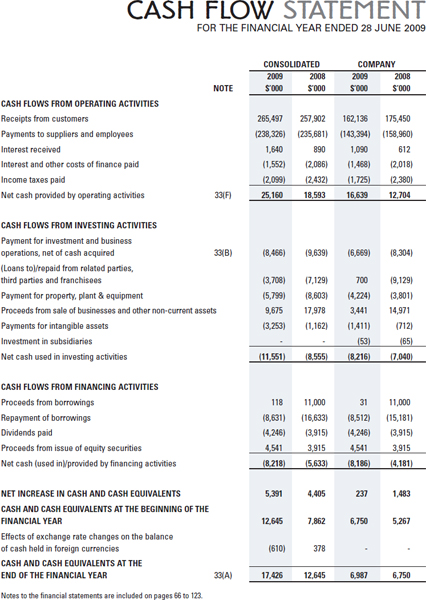
EXHIBIT 2-15C DOMINO'S PIZZA ENTERPRISES LIMITED 2009 ANNUAL REPORT
DOMINO'S PIZZA ENTERPRISES LIMITED 2009 ANNUAL REPORT
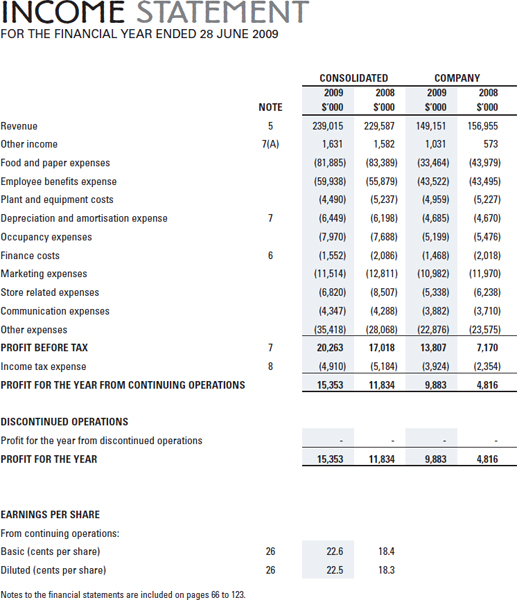
 EXHIBIT 2-15D DOMINO'S PIZZA ENTERPRISES LIMITED 2009 ANNUAL REPORT
EXHIBIT 2-15D DOMINO'S PIZZA ENTERPRISES LIMITED 2009 ANNUAL REPORT
BEYOND THE BOOK
2-51 (Examine a Canadian company's annual report)
Find the annual report of a Canadian company in the retailing business, and answer the following questions:
- Who are the independent auditors for this company? Did they give the company an unqualified opinion?
- How important is inventory relative to the other assets on the company's statement of financial position (or balance sheet)?
- Does the company finance its business primarily with debt (funds borrowed from creditors) or with equity (funds invested by owners)?
- Read through the management discussion and analysis and determine whether there is any information there that is not included in the financial statements. If you were a shareholder, would you think the extra information is important? Why or why not?
- How many directors does the company have? What positions do they hold? Are any of them directors of other companies?
2-52 (Research a Canadian company)
Find at least three articles in the financial press about the company you chose for Problem 2-53. Write a one-page summary that discusses the nature of the company's markets and the forecast for this sector of the economy. (Hint: You might find recent articles about the company on its website.)
Cases
2-53 Wroad Wrunner Courier Service
At the end of her first year of university, Nola Lam decided that she wanted a summer job that would keep her outside enjoying the nice weather, so she set up her own courier service. She invested savings of $800 in the company, which she incorporated and called Wroad Wrunner. In addition, her parents loaned the company $2,200 to help it get started. Since this was a business venture, Nola insisted on paying interest on this loan and her parents agreed to charge a rate of 6% per year.
Nola then negotiated the purchase of a used car for the business for $4,000. The company made a down payment of $750 on the car, and financed the remainder of the purchase price at an interest rate of 12% per year. Nola estimated that the car could be sold at the end of the summer for $3,500.
Wroad Wrunner began operations on May 1, and continued until August 31. Although she did not keep any formal accounting records, at the end of the summer Nola put together the following additional information related to the business:
- During the summer, the company made payments of $623 on the car, which included interest of $123 and principal of $500.
- No payments (of either interest or principal) were made on the loan from her parents.
- Nola paid herself a salary of $1,500 per month for the four months that the business operated.
- Payments for other operating costs (including advertising, insurance, gas, etc.) totalled $1,100. In addition, there were unpaid bills totalling $100 at the end of August.
- Courier charges collected from customers totalled $9,300. In addition, customers still owed $300 for services performed in the last two weeks of August.
- After the close of business on August 31, there was a balance of $3,777 in the company's bank account, plus a “float” of $50 in the car.
Required:
- Analyze the transactions that affected the business during the summer. Prepare a statement of earnings for Wroad Wrunner for the four-month period ending on August 31, and a statement of financial position on that date.
- Comment on the profitability of the business during its four-month period of operations. How much did Nola make from her venture during the summer?
- Comment on the financial position of the company on August 31. If Nola dissolves the business before she returns to university, will there be enough cash to pay off the liabilities?
2-54 Daisy-Fresh Dry Cleaning
Daisy-Fresh Dry Cleaning is in the process of preparing its annual financial statements. The owner of the business is not an accountant, but likes to prepare the financial statements himself. Most of the business transactions are straightforward and can be easily recorded; however, the owner is having trouble determining how to account for the following events that occurred in during the year:
- On January 1, the company purchased a three-year insurance policy for $3,000. Because the entire amount had to be paid when the policy took effect, the owner charged $3,000 to expense in the current year.
- On July 1, the company bought a new dry-cleaning machine for $10,000. Although it is expected to have a five-year life, the owner thinks he would only get $2,000 for it if he sold it now, so he recorded an asset of $2,000 and an expense of $8,000.
- On October 31, the company borrowed $10,000 from a bank. Since the loan does not have to be repaid until four years later, the owner does not think it should be reported as a payable on this year's statement of financial position.
- No interest has to be paid on the loan until October 31 of next year, so the owner did not record any interest this year.
- On December 31, the company declared and paid a dividend of $10,000. Because it is not an expenditure that will produce future benefits and is therefore not an asset, the owner recorded this payment as an expense.
Required:
Advise the owner as to how the above transactions should be recorded and reported in the financial statements for the current year.
2-55 Mega Manufacturing
Mega Manufacturing has calculated the following financial ratios, based on the company's comparative financial statements for 2011 and 2010:

Briefly explain what each of the ratios indicates, and comment on the company's performance during this two-year period.
Critical Thinking Question
2-56 (Consider the value of an ownership interest in a company)
One of the shareholders of The Canadian Cookies and Cakes Company is considering selling her one-third ownership and therefore wants to determine her equity in the cookie shop, using the correct accounting principles. The following transactions have occurred since the shop started operations at the beginning of this year:
- The company borrowed $30,000 from the bank to help get the business started, and repaid $10,000 of this before year end. Shareholders also contributed $30,000 to get the business started.
- Ingredients costing $42,000 were purchased on account, and 80% of these ingredients were used in goods that were baked and sold during the year. Before the end of the year, payments of $37,000 were made for these ingredients.
- Baking ovens were rented for $12,000 cash, paid at the rate of $1,000 per month. At the end of the year, the company purchased its own ovens for $46,000 cash.
- Employees earned wages of $30,000 during the year; the company withheld income taxes of $3,000 from their paycheques, which it will forward to the Canada Revenue Agency early next year. In other words, although the employees' wages were $30,000, the company deducted income taxes and paid only the remaining $27,000 net amount to the employees; it will pay the $3,000 of income taxes directly to the CRA. (Note that these income taxes relate to the employees' earnings, not the company's earnings. Consequently, they are recorded as part of the company's wages expense, not as income taxes expense.)
- Interest on the bank loan for the year totalled $1,600, but has not yet been paid.
- Various other expenses totalled $15,000 for the year, but only $13,500 of this amount was paid before the end of the year.
- After $98,000 was collected from the sale of goods (which was the full sales amount), the cash balance at the end of the year was $12,500, and net income of $5,800 was reported.
Required:
- Show calculations to prove that the ending cash balance was $12,500 and the net income for the year was $5,800.
- Prepare a statement of financial position for the bakery as of the end of the year.
- If the shareholder sells her one-third ownership interest in the bakery, what does the foregoing tell you regarding how much she should expect to get for her shares?




